-
 Artist: Utagawa Kunisada [歌川 国貞] a.k.a. Utagawa Toyokuni III [三代 歌川 豊国] (Japanese, 1786 – 1865). Signed: Kōchōrō Kunisada ga [香蝶楼国貞画] in a double-gourd cartouche. Iseya Sōemon [伊勢屋惣右衛門] (Japanese, 1776 – 1862); seal: Ue [上] (Marks 02-041 | 156a). Inscription in the red stripe: Five types of haiku in shōfū style [俳諧五流蕉風] (Haikai gōryū shōfū). Censor's seal: Watari [渡] (Watanabe Shōemon), VI/1842–V ic/1846. Media: Fan print [団扇絵] (Uchiwa-e); size: 225 x 292 mm. An uncut fan print depicts a young woman with an insect (firefly) cage in her left hand. Her striped kimono is adorned with the design of white, grey and blue cherry blossoms. Two of the Seven Grasses of Autumn [秋の七草] (aki no nanakusa), namely Platycodon grandiflorus (kikyō) [桔梗] a.k.a. Chinese bellflower (or balloon flower) and Patrinia scabiosifolia (ominaeshi) [女郎花] a. k.a. Eastern (or Golden) Valerian, are seen on her right-hand side.
Artist: Utagawa Kunisada [歌川 国貞] a.k.a. Utagawa Toyokuni III [三代 歌川 豊国] (Japanese, 1786 – 1865). Signed: Kōchōrō Kunisada ga [香蝶楼国貞画] in a double-gourd cartouche. Iseya Sōemon [伊勢屋惣右衛門] (Japanese, 1776 – 1862); seal: Ue [上] (Marks 02-041 | 156a). Inscription in the red stripe: Five types of haiku in shōfū style [俳諧五流蕉風] (Haikai gōryū shōfū). Censor's seal: Watari [渡] (Watanabe Shōemon), VI/1842–V ic/1846. Media: Fan print [団扇絵] (Uchiwa-e); size: 225 x 292 mm. An uncut fan print depicts a young woman with an insect (firefly) cage in her left hand. Her striped kimono is adorned with the design of white, grey and blue cherry blossoms. Two of the Seven Grasses of Autumn [秋の七草] (aki no nanakusa), namely Platycodon grandiflorus (kikyō) [桔梗] a.k.a. Chinese bellflower (or balloon flower) and Patrinia scabiosifolia (ominaeshi) [女郎花] a. k.a. Eastern (or Golden) Valerian, are seen on her right-hand side. -
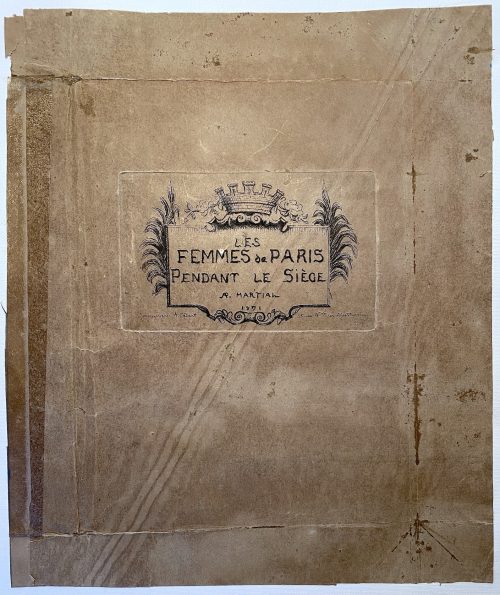 A suite of 12 etchings 160 x 118 mm each, in the first state, pasted on paper, 2 per sheet, with a cover (250 x 210 mm).0. Cover. Les femmes de Paris pendant le siège./R.Martial/1871.1. Lorsqu'à l'approche de l'ennemi on demandait l'éloignement des bouches inutiles [...] 2. L'Ennemi ! 3. No inscription 4. Quête pour les veuves. 5. Concert et quête pour les enfants blessés, malades, infirmes. 6. Au bastion/Et celles non moins précieuses qui dirigeaient ces ventes [...] 7. Vente pour les orphelins de la guerre. 8. No inscription 9. Une ration, bouillie romaine et Vin/Cantine municipale[...] 10. No inscription 11. No inscription 12. Les effets de cette union patriotique des femmes sont connus.[...]
A suite of 12 etchings 160 x 118 mm each, in the first state, pasted on paper, 2 per sheet, with a cover (250 x 210 mm).0. Cover. Les femmes de Paris pendant le siège./R.Martial/1871.1. Lorsqu'à l'approche de l'ennemi on demandait l'éloignement des bouches inutiles [...] 2. L'Ennemi ! 3. No inscription 4. Quête pour les veuves. 5. Concert et quête pour les enfants blessés, malades, infirmes. 6. Au bastion/Et celles non moins précieuses qui dirigeaient ces ventes [...] 7. Vente pour les orphelins de la guerre. 8. No inscription 9. Une ration, bouillie romaine et Vin/Cantine municipale[...] 10. No inscription 11. No inscription 12. Les effets de cette union patriotique des femmes sont connus.[...] -
 Artist: Utagawa Kunisada [歌川 国貞] a.k.a. Utagawa Toyokuni III [三代 歌川 豊国] (Japanese, 1786 – 1865). An untrimmed fan print titled Fuji Tsukuba aiaigasa, shows the actors Ichikawa Ebizo V [市川海老蔵] and the onnagata actor Iwai Shijaku I [岩井紫若] sharing an umbrella against the wind. Tsukuba, about 50 kilometres from Edo, was an area where both Fuji and Mount Tsukuba could be viewed together. Mount Fuji being the female and Mount Tsukuba the male. An aizuri-e background (common to all the designs in this set). A play on images and words. Actors: Ichikawa Danjūrō VII [市川団十郎] (Japanese, 1791 – 1859); other names: Ichikawa Ebizō V [市川海老蔵], Ichikawa Hakuen II, Ichikawa Shinnosuke I. Iwai Matsunosuke I [岩井松之助] (Japanese, 1804 – 1845); other names: Iwai Hanshirō VII, Iwai Shijaku I [岩井紫若], Iwai Komurasaki I. Publisher: Ibaya Senzaburo [伊場屋仙三郎] (Japanese, fl. c. 1845 – 1847). The publisher’s seal is on the umbrella. Date: circa 1832. Signed: Kōchōrō Kunisada ga in a red double-gourd cartouche. From the series of fan prints:
Artist: Utagawa Kunisada [歌川 国貞] a.k.a. Utagawa Toyokuni III [三代 歌川 豊国] (Japanese, 1786 – 1865). An untrimmed fan print titled Fuji Tsukuba aiaigasa, shows the actors Ichikawa Ebizo V [市川海老蔵] and the onnagata actor Iwai Shijaku I [岩井紫若] sharing an umbrella against the wind. Tsukuba, about 50 kilometres from Edo, was an area where both Fuji and Mount Tsukuba could be viewed together. Mount Fuji being the female and Mount Tsukuba the male. An aizuri-e background (common to all the designs in this set). A play on images and words. Actors: Ichikawa Danjūrō VII [市川団十郎] (Japanese, 1791 – 1859); other names: Ichikawa Ebizō V [市川海老蔵], Ichikawa Hakuen II, Ichikawa Shinnosuke I. Iwai Matsunosuke I [岩井松之助] (Japanese, 1804 – 1845); other names: Iwai Hanshirō VII, Iwai Shijaku I [岩井紫若], Iwai Komurasaki I. Publisher: Ibaya Senzaburo [伊場屋仙三郎] (Japanese, fl. c. 1845 – 1847). The publisher’s seal is on the umbrella. Date: circa 1832. Signed: Kōchōrō Kunisada ga in a red double-gourd cartouche. From the series of fan prints:
Two more prints from the series 'Fuji and Tsukuba sharing an umbrella' (Fuji Tsukuba aiaigasa), not in this Collection:
SVJP-0341.2021

Kabuki actors Onoe Kikugorō III and Iwai Kumesaburo II. Year: c. 1832; Publisher: No seal; Signed: Kōchōrō Kunisada ga From Kunisada Project. 
Kabuki actors Bandō Minosuke II and Iwai Shijaku I. Year: c. 1832; Publisher: No seal; Signed: Kōchōrō Kunisada ga From Kunisada Project. -
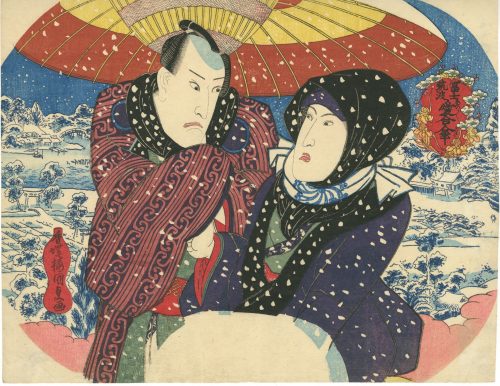 Artist: Utagawa Kunisada [歌川 国貞], a.k.a. Utagawa Toyokuni III [三代 歌川 豊国] (Japanese, 1786 – 1865). An untrimmed fan print titled Fuji Tsukuba aiaigasa, shows the actors Nakamura Shikan II [二代目中村芝翫] and the onnagata actor Iwai Kumesaburō II [岩井粂三郎] sharing an umbrella against the snow. Tsukuba, about 50 kilometres from Edo, was an area where both Fuji and Mount Tsukuba could be viewed together. Mount Fuji being the female and Mount Tsukuba the male. An aizuri-e background (common to all the designs in this set). A play on images and words. Actors: Nakamura Utaemon IV [中村歌右衛門] (Japanese, 1796 – 1852); other names: Nakamura Shikan II [二代目中村芝翫], Nakamura Tsurusuke I, Nakamura Tōtarō. Iwai Hanshirō VI [[岩井半四郎] (Japanese, 1799 – 1836); other names: Iwai Hanshirō VI, Iwai Kumesaburō II [岩井粂三郎], Iwai Hisajirō I, Baiga (poetry name), Shūka (poetry name). Publisher: Ibaya Senzaburo [伊場屋仙三郎] (Japanese, fl. c. 1845 – 1847). Date: circa 1832. Signed: Kōchōrō Kunisada ga in a red double-gourd cartouche. From the series of fan prints:
Artist: Utagawa Kunisada [歌川 国貞], a.k.a. Utagawa Toyokuni III [三代 歌川 豊国] (Japanese, 1786 – 1865). An untrimmed fan print titled Fuji Tsukuba aiaigasa, shows the actors Nakamura Shikan II [二代目中村芝翫] and the onnagata actor Iwai Kumesaburō II [岩井粂三郎] sharing an umbrella against the snow. Tsukuba, about 50 kilometres from Edo, was an area where both Fuji and Mount Tsukuba could be viewed together. Mount Fuji being the female and Mount Tsukuba the male. An aizuri-e background (common to all the designs in this set). A play on images and words. Actors: Nakamura Utaemon IV [中村歌右衛門] (Japanese, 1796 – 1852); other names: Nakamura Shikan II [二代目中村芝翫], Nakamura Tsurusuke I, Nakamura Tōtarō. Iwai Hanshirō VI [[岩井半四郎] (Japanese, 1799 – 1836); other names: Iwai Hanshirō VI, Iwai Kumesaburō II [岩井粂三郎], Iwai Hisajirō I, Baiga (poetry name), Shūka (poetry name). Publisher: Ibaya Senzaburo [伊場屋仙三郎] (Japanese, fl. c. 1845 – 1847). Date: circa 1832. Signed: Kōchōrō Kunisada ga in a red double-gourd cartouche. From the series of fan prints:
Two more prints from the series 'Fuji and Tsukuba sharing an umbrella' (Fuji Tsukuba aiaigasa), not in this Collection:
SVJP-0342.2021

Kabuki actors Onoe Kikugorō III and Iwai Kumesaburo II. Year: c. 1832; Publisher: No seal; Signed: Kōchōrō Kunisada ga From Kunisada Project. 
Kabuki actors Bandō Minosuke II and Iwai Shijaku I. Year: c. 1832; Publisher: No seal; Signed: Kōchōrō Kunisada ga From Kunisada Project. -
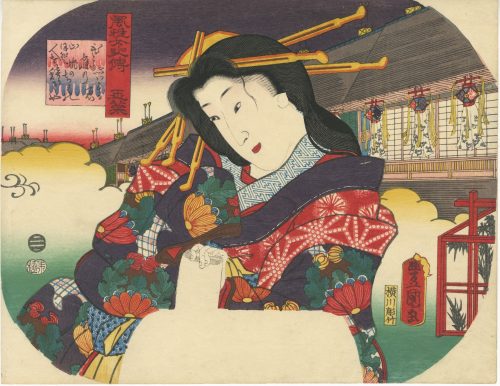 Artist: Utagawa Kunisada [歌川 国貞], a.k.a. Utagawa Toyokuni III [三代 歌川 豊国] (Japanese, 1786 – 1865). Signed: Toyokuni ga [豊国 画] in a red toshidama cartouche Block carver: Yokokawa Takejirō [横川竹二郎] (Japanese, fl. 1845 – 1863), seal: 彫竹 – hori Take. Publisher: Ibaya Senzaburō [伊場屋仙三郎] (Japanese, fl. c. 1845 – 1847). Media: Untrimmed fan print (uchiwa-e), 232 x 300 mm. Title: Tamagiku [玉菜]. Series: Chronicles of Elegant Women [風雅女史傳] (Fūga joshiden). Combined date seal and kiwame censor seal: Ansei 6 (1859). Other prints from the same series in this collection [SVJP-0216.2016] — Princess Sotoori:
Artist: Utagawa Kunisada [歌川 国貞], a.k.a. Utagawa Toyokuni III [三代 歌川 豊国] (Japanese, 1786 – 1865). Signed: Toyokuni ga [豊国 画] in a red toshidama cartouche Block carver: Yokokawa Takejirō [横川竹二郎] (Japanese, fl. 1845 – 1863), seal: 彫竹 – hori Take. Publisher: Ibaya Senzaburō [伊場屋仙三郎] (Japanese, fl. c. 1845 – 1847). Media: Untrimmed fan print (uchiwa-e), 232 x 300 mm. Title: Tamagiku [玉菜]. Series: Chronicles of Elegant Women [風雅女史傳] (Fūga joshiden). Combined date seal and kiwame censor seal: Ansei 6 (1859). Other prints from the same series in this collection [SVJP-0216.2016] — Princess Sotoori: SVJP-0400.2023 — Saiko:
SVJP-0400.2023 — Saiko:
 Note by Elena Varshavsky:
Tamagiku [玉菜] (Japanese, 1702 – 1726) – Precious Chrysanthemum (translated also as Jade Chrysanthemum; one can say also Gem Chrysanthemum). She was a courtesan famous for her beauty, kind heart, and countless artistic accomplishments. She died young and was deeply grieved by the establishment of Nakamanji-ya (中万字屋) for which she worked, and beyond. Her memory was celebrated during the Bon festival of the commemoration of the dead, and lanterns were hung at the gallery of that establishment and other neighbouring ones to commemorate her and appease her soul. These lanterns are seen behind her. Kabuki plays were continuously dedicated to her, she figured in Edo period literature and was often portrayed on ukiyo-e prints. In many cases, she was shown with the lanterns associated with her. Those lanterns were called “Tamagiku Lanterns”.
Other depictions of Tamagiku:
Note by Elena Varshavsky:
Tamagiku [玉菜] (Japanese, 1702 – 1726) – Precious Chrysanthemum (translated also as Jade Chrysanthemum; one can say also Gem Chrysanthemum). She was a courtesan famous for her beauty, kind heart, and countless artistic accomplishments. She died young and was deeply grieved by the establishment of Nakamanji-ya (中万字屋) for which she worked, and beyond. Her memory was celebrated during the Bon festival of the commemoration of the dead, and lanterns were hung at the gallery of that establishment and other neighbouring ones to commemorate her and appease her soul. These lanterns are seen behind her. Kabuki plays were continuously dedicated to her, she figured in Edo period literature and was often portrayed on ukiyo-e prints. In many cases, she was shown with the lanterns associated with her. Those lanterns were called “Tamagiku Lanterns”.
Other depictions of Tamagiku:

Tamagiku (Ancient and modern women's biography) by Kunisada, 1859.

Courtesan Tamagiku by Kunichika.

Tamagiku of the Nakamanjiya, Inaki Shinnojō, and Nakamanjiya Yahei (looking through the window) by Kunisada.

Nakamanji-Ya Tamagiku by Kunisada
Sources: darumapedia; kajiipeta; kabuki21; crosseyedgallery.
Nakamanji-Ya Tamagiku by Kunisada, 1857
-
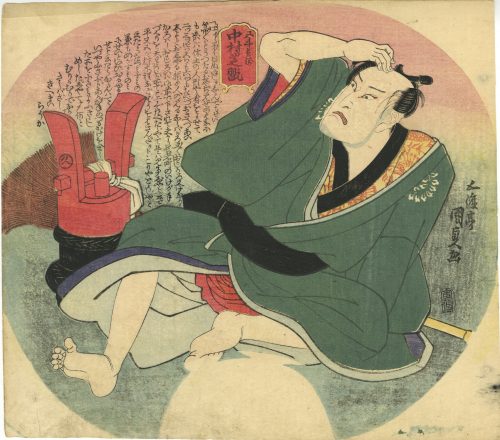 Artist: Utagawa Kunisada [歌川 国貞] a.k.a. Utagawa Toyokuni III [三代歌川豊国] (Japanese, 1786 – 1865). Signed: Gototei Kunisada ga [五渡亭国貞画]. Publisher: Ibaya Kyūbei [伊場屋 久兵衛] (Japanese, 1804 – 1851); seal Marks 08-055|126a. Date-aratame seal: Bunsei 13 / Tenpō 1 (1830). Actor: Nakamura Utaemon IV [中村歌右衛門] (Japanese, 1796 – 1852); other names: Nakamura Shikan II [中村芝翫], Nakamura Tsurusuke I, Nakamura Tōtarō. Play: Yoshitsune’s Letter at Koshigoe [義経腰越状] (Yoshitsune Koshigoe-jo). Uncut fan print (uchiwa-e, 団 扇 絵) depicting kabuki actor Nakamura Shikan [中村芝翫] as Gotobei [五斗兵衛], dressed in a green kimono with hanging wisteria crest (sagari fuji mon) on the shoulder, posing behind a large saké cask. Nakamura Utaemon IV held the name of Nakamura Shikan II from the 11th lunar month of 1825 to the 1st lunar month of 1836. He was born as Hirano Kichitarō in Edo in 1796. Another fan print with the same subject in this collection [SVJP-0349.2021]; there are also more details about the play and its heroes.
Artist: Utagawa Kunisada [歌川 国貞] a.k.a. Utagawa Toyokuni III [三代歌川豊国] (Japanese, 1786 – 1865). Signed: Gototei Kunisada ga [五渡亭国貞画]. Publisher: Ibaya Kyūbei [伊場屋 久兵衛] (Japanese, 1804 – 1851); seal Marks 08-055|126a. Date-aratame seal: Bunsei 13 / Tenpō 1 (1830). Actor: Nakamura Utaemon IV [中村歌右衛門] (Japanese, 1796 – 1852); other names: Nakamura Shikan II [中村芝翫], Nakamura Tsurusuke I, Nakamura Tōtarō. Play: Yoshitsune’s Letter at Koshigoe [義経腰越状] (Yoshitsune Koshigoe-jo). Uncut fan print (uchiwa-e, 団 扇 絵) depicting kabuki actor Nakamura Shikan [中村芝翫] as Gotobei [五斗兵衛], dressed in a green kimono with hanging wisteria crest (sagari fuji mon) on the shoulder, posing behind a large saké cask. Nakamura Utaemon IV held the name of Nakamura Shikan II from the 11th lunar month of 1825 to the 1st lunar month of 1836. He was born as Hirano Kichitarō in Edo in 1796. Another fan print with the same subject in this collection [SVJP-0349.2021]; there are also more details about the play and its heroes. Horst Graebner also noted that the performance took place at Nakamura Theatre in Edo on Bunsei 13/03 (03/1830) (see Waseda University Cultural Resources Database # 100-4224):
Horst Graebner also noted that the performance took place at Nakamura Theatre in Edo on Bunsei 13/03 (03/1830) (see Waseda University Cultural Resources Database # 100-4224):

Toyokuni II
-
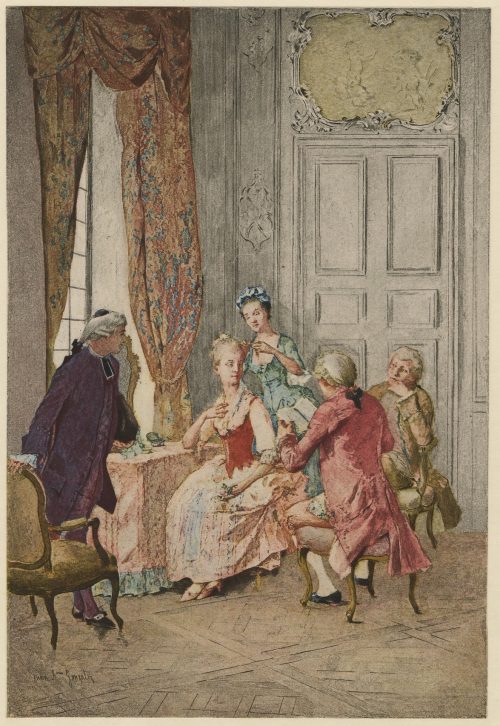
Coloured etching by E. Charreyre (French, fl. 1880 – ?) after a watercolour by Juan Antonio González, (Spanish, 1842 – 1914). A book illustration for 'Son Altesse La Femme' by Octave Uzanne (1851 – 1931), chapter: 'La Caillette' (Le lever d’une petite-maitresse au XVIIIe siècle). Published by Albert Quantin (French, 1850 – 1930) in 1885.
Size: print 17.5 x 12 cm, pasted to leaf 27.7 x 19.5 cm.
-
 Artist: Utagawa Kunisada [歌川 国貞], a.k.a. Utagawa Toyokuni III [三代 歌川 豊国] (Japanese, 1786 – 1865). Signed: Toyokuni ga [豊国 画] in a red toshidama cartouche Block carver: Yokokawa Takejirō [横川竹二郎] (Japanese, fl. 1845 – 1863); seal: Hori Take [彫竹]. Publisher: Iseya Magobei [伊勢屋孫兵衛] (Japanese, fl. c. 1794 – 1868); seal: Hanmoto, Masu [板元, 益] (Marks 19-039 | 150d). Date-aratame seal: Ansei 2 (1855). Title: Time in Fukagawa, Iyo Province (Fukagawa Iyo setsu). Ref.: [LIB-3008.2022] Andreas Marks. Japanese woodblock prints: Artists, publishers and masterworks, 1680 – 1900. — Tuttle Publishing, 2010; p. 221. –> 1855 Kunisada. "Iyo Province-time at Fukagawa" (Fukagawa Iyo setsu). Fan print. Japan Ukiyo-e Museum, Matsumoto.
Artist: Utagawa Kunisada [歌川 国貞], a.k.a. Utagawa Toyokuni III [三代 歌川 豊国] (Japanese, 1786 – 1865). Signed: Toyokuni ga [豊国 画] in a red toshidama cartouche Block carver: Yokokawa Takejirō [横川竹二郎] (Japanese, fl. 1845 – 1863); seal: Hori Take [彫竹]. Publisher: Iseya Magobei [伊勢屋孫兵衛] (Japanese, fl. c. 1794 – 1868); seal: Hanmoto, Masu [板元, 益] (Marks 19-039 | 150d). Date-aratame seal: Ansei 2 (1855). Title: Time in Fukagawa, Iyo Province (Fukagawa Iyo setsu). Ref.: [LIB-3008.2022] Andreas Marks. Japanese woodblock prints: Artists, publishers and masterworks, 1680 – 1900. — Tuttle Publishing, 2010; p. 221. –> 1855 Kunisada. "Iyo Province-time at Fukagawa" (Fukagawa Iyo setsu). Fan print. Japan Ukiyo-e Museum, Matsumoto. -
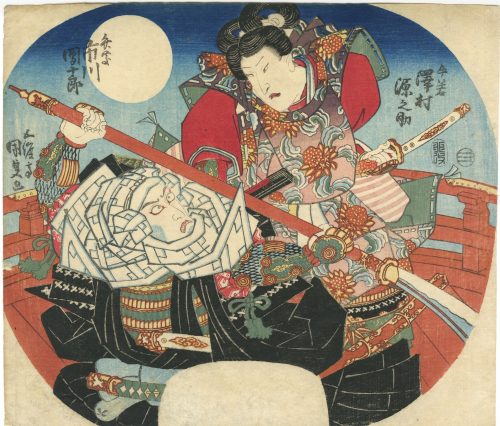 Sawamura Gennosuke II [沢村源之助] (Suketakaya Takasuke III, Sawamura Chōjūrō V, Sawamura Sōjūrō V, Sawamura Tosshō I, Sawamura Genpei I, Japanese, 1802/7 – 1853) as Ushiwakamaru [牛若丸], a.k.a. Minamoto no Yoshitsune [源 義経]. Ichikawa Danjūrō VII [市川団十郎] (Ichikawa Ebizō V, Ichikawa Hakuen II, Ichikawa Shinnosuke I, Japanese, 1791 – 1859) as Benkei, a.k.a. Saitō Musashibō Benkei [西塔武蔵坊弁慶] (Japanese, 1155 – 1189) Performance: Grand finale dance play [大切所作事] (ōgiri shosagoto) at Soga Festival - A Composite Piece of Musashi「曽我祭武蔵摂物 ごさいれいむさしのひきもの)」 (Gosairei Musashi no hikimono), performed at Kawarazakiza (河原崎座) in 05/1831 (See kabuki plays from 1831). Soga Festival (Soga Matsuri) is an annual theatre event in Edo (Tokyo). Scene: The Fight on Gojo Bridge or Benkei on the Bridge [橋弁慶] (Hashi Benkei). The story relates how Benkei, first a monk, then a mountain ascetic, and then a rogue warrior, a man of Herculean strength, was subdued by the young Onzoshi Ushiwaka Maru (Yoshitsune) on Gojo Bridge. Benkei wandered around Kyoto with the intention of relieving 1000 samurai of their swords. One night, with one more sword to go, he saw Yoshitsune playing the flute and wearing a golden sword at the Gojotenjin Shrine. They agreed to fight on Gojo Bridge in southern Kyoto. However, Yoshitsune was too agile for Benkei and had been educated in the secrets of fighting by the tengu. Following Yoshitsune’s victory, Benkei became Yoshitsune’s retainer. Artist: Utagawa Kunisada [歌川 国貞], a.k.a. Toyokuni III (Japanese, 1786 – 1865). Publisher: Ibaya Senzaburo [伊場屋仙三郎]. Signed: Gototei Kunisada ga [五渡亭国貞画]. Date-aratame seal: Tenpō 2 (1831). Size: Fan print (uchiwa-e). Ref.: (1) Tokyo Metropolitan Library, 請求記号 M339-6/東M339-006. (2) Ritsumeikan University, Art Research Center, Portal Database M339-006(02).
Sawamura Gennosuke II [沢村源之助] (Suketakaya Takasuke III, Sawamura Chōjūrō V, Sawamura Sōjūrō V, Sawamura Tosshō I, Sawamura Genpei I, Japanese, 1802/7 – 1853) as Ushiwakamaru [牛若丸], a.k.a. Minamoto no Yoshitsune [源 義経]. Ichikawa Danjūrō VII [市川団十郎] (Ichikawa Ebizō V, Ichikawa Hakuen II, Ichikawa Shinnosuke I, Japanese, 1791 – 1859) as Benkei, a.k.a. Saitō Musashibō Benkei [西塔武蔵坊弁慶] (Japanese, 1155 – 1189) Performance: Grand finale dance play [大切所作事] (ōgiri shosagoto) at Soga Festival - A Composite Piece of Musashi「曽我祭武蔵摂物 ごさいれいむさしのひきもの)」 (Gosairei Musashi no hikimono), performed at Kawarazakiza (河原崎座) in 05/1831 (See kabuki plays from 1831). Soga Festival (Soga Matsuri) is an annual theatre event in Edo (Tokyo). Scene: The Fight on Gojo Bridge or Benkei on the Bridge [橋弁慶] (Hashi Benkei). The story relates how Benkei, first a monk, then a mountain ascetic, and then a rogue warrior, a man of Herculean strength, was subdued by the young Onzoshi Ushiwaka Maru (Yoshitsune) on Gojo Bridge. Benkei wandered around Kyoto with the intention of relieving 1000 samurai of their swords. One night, with one more sword to go, he saw Yoshitsune playing the flute and wearing a golden sword at the Gojotenjin Shrine. They agreed to fight on Gojo Bridge in southern Kyoto. However, Yoshitsune was too agile for Benkei and had been educated in the secrets of fighting by the tengu. Following Yoshitsune’s victory, Benkei became Yoshitsune’s retainer. Artist: Utagawa Kunisada [歌川 国貞], a.k.a. Toyokuni III (Japanese, 1786 – 1865). Publisher: Ibaya Senzaburo [伊場屋仙三郎]. Signed: Gototei Kunisada ga [五渡亭国貞画]. Date-aratame seal: Tenpō 2 (1831). Size: Fan print (uchiwa-e). Ref.: (1) Tokyo Metropolitan Library, 請求記号 M339-6/東M339-006. (2) Ritsumeikan University, Art Research Center, Portal Database M339-006(02).
-
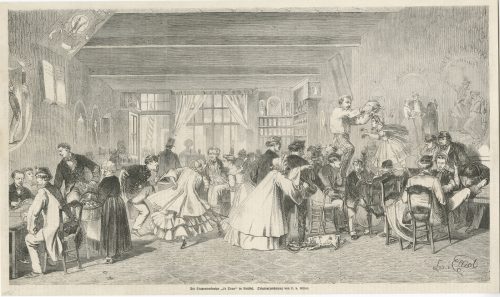
A woodcut illustration after drawing by Leo von Elliot, published at Illustrirte Zeitung, 17 January 1863. English translation: Student bar "The Hole" in Brussels.
The official name of this bar, located at Rue des Sols in Bussels, was "À la vue de l'Université" (In sight of the University). This was the place where the students of the Université libre de Bruxelles (Free University of Brussels), and especially the members of Société, ou Cercle, des Crocodiles (The Crocodile Society, or Circle), gathered in the 1860s. -
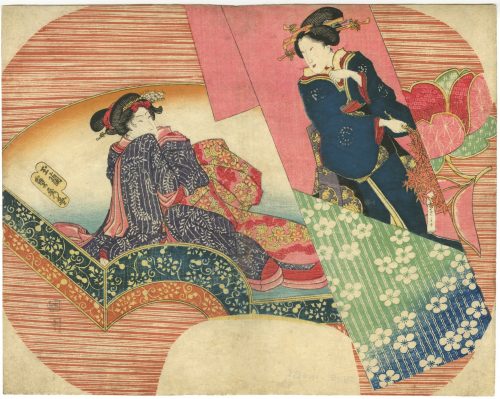 Artist: Utagawa Sadahide [歌川貞秀] (Japanese, 1807 – 1879). Publisher: Kojimaya Jūbei [小島屋重兵衛] (Japanese, c. 1797 – 1869); seal: Marks #264, p. 210) Signed: Gyokuransai Sadahide ga [玉蘭斎貞秀 画]. Date seal: 1830 (Bunsei 13 / Tenpō 1). Size: Uncut fan print (uchiwa-e); 229 x 292 mm
Artist: Utagawa Sadahide [歌川貞秀] (Japanese, 1807 – 1879). Publisher: Kojimaya Jūbei [小島屋重兵衛] (Japanese, c. 1797 – 1869); seal: Marks #264, p. 210) Signed: Gyokuransai Sadahide ga [玉蘭斎貞秀 画]. Date seal: 1830 (Bunsei 13 / Tenpō 1). Size: Uncut fan print (uchiwa-e); 229 x 292 mm -
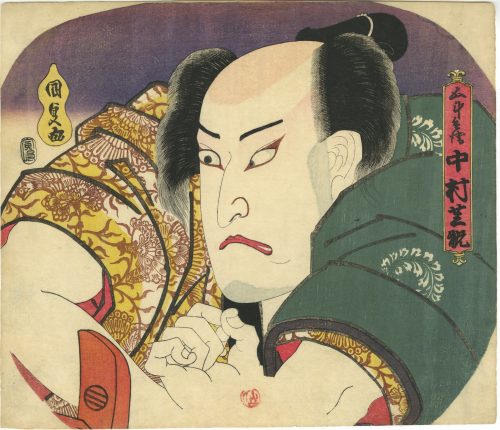 Artist: Utagawa Kunisada [歌川 国貞] a.k.a. Utagawa Toyokuni III [三代歌川豊国] (Japanese, 1786 – 1865). Signed: Kunisada ga [国貞画] in a yellow double-gourd cartouche. Publisher: Ibaya Senzaburo [伊場屋仙三郎] (Japanese, fl. c. 1845 – 1847). Date aratame seal: Bunsei 13 – Tenpō 1 (1830). Actor: Nakamura Utaemon IV [中村歌右衛門] (Japanese, 1796 – 1852); other names: Nakamura Shikan II [二代目中村芝翫], Nakamura Tsurusuke I, Nakamura Tōtarō. Play: Yoshitsune’s Letter at Koshigoe [義経腰越状] (Yoshitsune Koshigoe-jo). Uncut fan print (uchiwa-e, 団 扇 絵), 229 x 267 mm, depicting kabuki actor Nakamura Shikan [中村芝翫] as Gotobei [五斗兵衛]. Nakamura Utaemon IV held the name of Nakamura Shikan II from the 11th lunar month of 1825 to the 1st lunar month of 1836. He was born as Hirano Kichitarō in Edo in 1796. Another fan print with the same subject in this collection [SVJP-0344.2021]:
Artist: Utagawa Kunisada [歌川 国貞] a.k.a. Utagawa Toyokuni III [三代歌川豊国] (Japanese, 1786 – 1865). Signed: Kunisada ga [国貞画] in a yellow double-gourd cartouche. Publisher: Ibaya Senzaburo [伊場屋仙三郎] (Japanese, fl. c. 1845 – 1847). Date aratame seal: Bunsei 13 – Tenpō 1 (1830). Actor: Nakamura Utaemon IV [中村歌右衛門] (Japanese, 1796 – 1852); other names: Nakamura Shikan II [二代目中村芝翫], Nakamura Tsurusuke I, Nakamura Tōtarō. Play: Yoshitsune’s Letter at Koshigoe [義経腰越状] (Yoshitsune Koshigoe-jo). Uncut fan print (uchiwa-e, 団 扇 絵), 229 x 267 mm, depicting kabuki actor Nakamura Shikan [中村芝翫] as Gotobei [五斗兵衛]. Nakamura Utaemon IV held the name of Nakamura Shikan II from the 11th lunar month of 1825 to the 1st lunar month of 1836. He was born as Hirano Kichitarō in Edo in 1796. Another fan print with the same subject in this collection [SVJP-0344.2021]: "...The play Yoshitsune Koshigoe-jo was originally written for the puppet theatre (Bunraku) and staged for the first time in the 7th lunar month of 1754 in Ôsaka at the Toyotakeza. It was a revision of two early plays, Namiki Sōsuke's Nanbantetsu Gotō no Menuki (1735) and Yoshitsune Shin Fukumijō (1744). The title, which suggested that the play focused on Minamoto no Yoshitsune, was in fact dealing with the siege of the Ōsaka Castle, led by Tokugawa Ieyasu to destroy the Toyotomi clan in 1614 and 1615. This play was quickly forbidden because of the 4th act in which Gotobei's wife fired a gun at Yoritomo (this was of course interpreted as an attack on the Shogunate). Yoshitsune Koshigoe-jo was revised in 1770 by Toyotake Ōritsu, who completely rewrote the 4th act for a puppet production at the Kitahorieza in Ōsaka". Yoshitsune Koshigoe-jo was staged for the first time in Edo, at the Ichimuraza on the 9th lunar month of 1790, and is still performed.
Gotobei [五斗兵衛] (Gotohei or Gotobē), one of Yoshitsune’s loyal retainers, is forced to choose between his son’s life or his loyalty to Yoshitsune. Nishikidō brothers, who do not want Gotobei to become Yoshitsune's chief strategist, forced him to drink sake and get asleep. To prove Gotobei's military abilities, Izumi no Saburō fires a gun next to Gotobei's ear, and "he jumps up immediately, in full possession of his senses, ready to repulse any enemy". See: [LIB-1193.2013] Samuel L. Leiter. Kabuki Encyclopedia: An English-language adaptation of Kabuki Jiten. — Westport, CT; London: Greenwood Press, 1979; pp. 266-7).
Ref: [LIB-2993.2022] Fig. 24 in Israel Goldman. Japanese prints and paintings / 40th anniversary; Catalogue 27, 2021.
Two more Kunisada's fan prints (in Paul Griffith's collection), depicting the same actor Nakamura Shikan II as Toneri Matsuōmaru [舎人松王丸] were published in 1832 by Iseya Ichiemon. The play was Sugawara's Secrets of Calligraphy [菅原伝授手習鑑] (Sugawara Denju Tenarai Kagami). See: [LIB-1212.2017] Robert Schaap. Kunisada: Imaging, drama and beauty / Introduction by Sebastian Izzard, contributions by Paul Griffith and Henk. J. Herwig. — Leiden: Hotei Publishing, ©2016.
"...The play Yoshitsune Koshigoe-jo was originally written for the puppet theatre (Bunraku) and staged for the first time in the 7th lunar month of 1754 in Ôsaka at the Toyotakeza. It was a revision of two early plays, Namiki Sōsuke's Nanbantetsu Gotō no Menuki (1735) and Yoshitsune Shin Fukumijō (1744). The title, which suggested that the play focused on Minamoto no Yoshitsune, was in fact dealing with the siege of the Ōsaka Castle, led by Tokugawa Ieyasu to destroy the Toyotomi clan in 1614 and 1615. This play was quickly forbidden because of the 4th act in which Gotobei's wife fired a gun at Yoritomo (this was of course interpreted as an attack on the Shogunate). Yoshitsune Koshigoe-jo was revised in 1770 by Toyotake Ōritsu, who completely rewrote the 4th act for a puppet production at the Kitahorieza in Ōsaka". Yoshitsune Koshigoe-jo was staged for the first time in Edo, at the Ichimuraza on the 9th lunar month of 1790, and is still performed.
Gotobei [五斗兵衛] (Gotohei or Gotobē), one of Yoshitsune’s loyal retainers, is forced to choose between his son’s life or his loyalty to Yoshitsune. Nishikidō brothers, who do not want Gotobei to become Yoshitsune's chief strategist, forced him to drink sake and get asleep. To prove Gotobei's military abilities, Izumi no Saburō fires a gun next to Gotobei's ear, and "he jumps up immediately, in full possession of his senses, ready to repulse any enemy". See: [LIB-1193.2013] Samuel L. Leiter. Kabuki Encyclopedia: An English-language adaptation of Kabuki Jiten. — Westport, CT; London: Greenwood Press, 1979; pp. 266-7).
Ref: [LIB-2993.2022] Fig. 24 in Israel Goldman. Japanese prints and paintings / 40th anniversary; Catalogue 27, 2021.
Two more Kunisada's fan prints (in Paul Griffith's collection), depicting the same actor Nakamura Shikan II as Toneri Matsuōmaru [舎人松王丸] were published in 1832 by Iseya Ichiemon. The play was Sugawara's Secrets of Calligraphy [菅原伝授手習鑑] (Sugawara Denju Tenarai Kagami). See: [LIB-1212.2017] Robert Schaap. Kunisada: Imaging, drama and beauty / Introduction by Sebastian Izzard, contributions by Paul Griffith and Henk. J. Herwig. — Leiden: Hotei Publishing, ©2016.


-
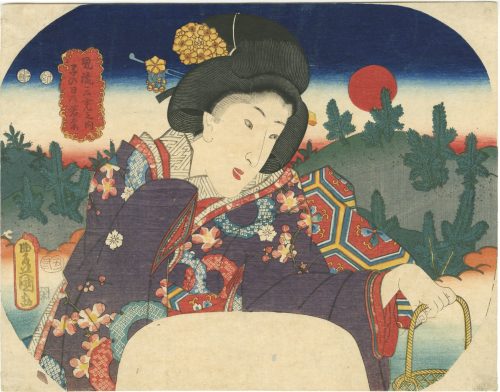 An uncut fan print shows a young woman holding a basket on a landscape background with hills and pines under a rising sun. Haruo Shirane: "Under the luni-solar calendar, the New Year coincided with the beginning of spring, making it the most important observance of the year for the aristocracy. In the Heian period, New Year ceremonies extended from New Year’s Day (Ganjitsu) to the Day of the Rat (Nenohi), which usually fell on the seventh day of the First Month, when courtiers went out to the fields (no), pulled up small pines, and gathered new herbs (wakana) as a prayer for long life. This ritual gradually spread to the provinces and to commoners, eventually resulting in the New Year practice of the gate pine (kadomatsu), in which a pair of small pines was placed at the gate of a house. A popular Heian-period painting topic representing the First Month was “prayers on the Day of the Rat” (Nenohi no asobi), which depicted the auspicious scene of pulling up small pines in a spring field. Both young herbs and gathering young herbs, particularly at Kasuga Field, became major poetic topics for the First Month, appearing in both the spring and celebration (ga) books of the Kokinshū (Collection of Japanese Poems Old and New, ca. 905). By the Kamakura period, the observance of the Day of the Rat had been abandoned at the imperial court, but the custom of gathering and eating young greens continued as the annual ceremony known as the Seven Grasses (Nanakusa). Note: The Heian-period ritual of pulling up the roots of small pines (komatsu ) on the first Day of the Rat derives from the homonyms ne (rat) and ne (root). Pulling up roots was auspicious, since it implied lengthening the year. The rising sun (hinode) was considered an auspicious sight, particularly at the beginning of the year". [Haruo Shirane, Japan and the Culture of the Four Seasons. Nature, Literature, and the Arts. — Columbia University, NY, 2012]. Title: Gathering of the young herbs on the Day of the Rat [子の日乃若菜] (Nenohi no wakana). Series: Three elegant sources of light [風流三光の内] (fūryū sankō no uchi); meaning the sun, the moon and the stars). Artist: Utagawa Kunisada [歌川 国貞]; a.k.a. Utagawa Toyokuni III [三代歌川豊国] (Japanese, 1786 – 1865). Signed: Toyokuni ga [豊国 画] in a yellow toshidama cartouche. Publisher’s seal: Izuzen (Marks: seal 06-029 | U103b) Date and double nanushi censor seals: Mera and Watanabe, Kaei 6 (1853). A similar theme can be found in Kunisadai's triptych published in about 1844 (HARA SHOBO):
An uncut fan print shows a young woman holding a basket on a landscape background with hills and pines under a rising sun. Haruo Shirane: "Under the luni-solar calendar, the New Year coincided with the beginning of spring, making it the most important observance of the year for the aristocracy. In the Heian period, New Year ceremonies extended from New Year’s Day (Ganjitsu) to the Day of the Rat (Nenohi), which usually fell on the seventh day of the First Month, when courtiers went out to the fields (no), pulled up small pines, and gathered new herbs (wakana) as a prayer for long life. This ritual gradually spread to the provinces and to commoners, eventually resulting in the New Year practice of the gate pine (kadomatsu), in which a pair of small pines was placed at the gate of a house. A popular Heian-period painting topic representing the First Month was “prayers on the Day of the Rat” (Nenohi no asobi), which depicted the auspicious scene of pulling up small pines in a spring field. Both young herbs and gathering young herbs, particularly at Kasuga Field, became major poetic topics for the First Month, appearing in both the spring and celebration (ga) books of the Kokinshū (Collection of Japanese Poems Old and New, ca. 905). By the Kamakura period, the observance of the Day of the Rat had been abandoned at the imperial court, but the custom of gathering and eating young greens continued as the annual ceremony known as the Seven Grasses (Nanakusa). Note: The Heian-period ritual of pulling up the roots of small pines (komatsu ) on the first Day of the Rat derives from the homonyms ne (rat) and ne (root). Pulling up roots was auspicious, since it implied lengthening the year. The rising sun (hinode) was considered an auspicious sight, particularly at the beginning of the year". [Haruo Shirane, Japan and the Culture of the Four Seasons. Nature, Literature, and the Arts. — Columbia University, NY, 2012]. Title: Gathering of the young herbs on the Day of the Rat [子の日乃若菜] (Nenohi no wakana). Series: Three elegant sources of light [風流三光の内] (fūryū sankō no uchi); meaning the sun, the moon and the stars). Artist: Utagawa Kunisada [歌川 国貞]; a.k.a. Utagawa Toyokuni III [三代歌川豊国] (Japanese, 1786 – 1865). Signed: Toyokuni ga [豊国 画] in a yellow toshidama cartouche. Publisher’s seal: Izuzen (Marks: seal 06-029 | U103b) Date and double nanushi censor seals: Mera and Watanabe, Kaei 6 (1853). A similar theme can be found in Kunisadai's triptych published in about 1844 (HARA SHOBO):
豊国三代「豊歳子日若菜摘ノ図」
-
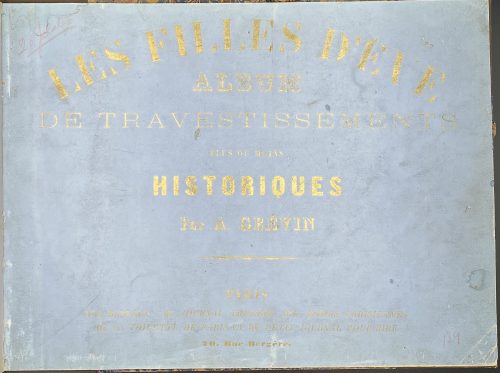 Pictorial album of 20 hand-coloured wood engravings by Firmin Gillot after Alfred Grévin; numbered 1 to 20, bound with tissue guards in half-brown cloth over marbled boards, publisher's gilt-lettered blue wrappers preserved, purple-blueish endpapers. Front wrapper (gilt on blue): LES FILLES D'EVE | ALBUM | DE TRAVESTISSEMENTS | PLUS OU MOINS | HISTORIQUES | Par A. GRÉVIN | — | PARIS | AUX BUREAUX : DU JOURNAL AMUSANT, DES MODES PARISIENNES | DE LA TOILETTE DE PARIS ET DU PETIT JOURNAL POUR RIRE | 20. Rue Bergère. || ; Henri Plon's imprint to back wrapper. Contributors: Grevin, Alfred (French, 1827 – 1892) Gillot, Firmin (French, 1820 – 1872) Plon, Henri (French, 1806 – 1872) Ref.: Metropoliten Museum.
Pictorial album of 20 hand-coloured wood engravings by Firmin Gillot after Alfred Grévin; numbered 1 to 20, bound with tissue guards in half-brown cloth over marbled boards, publisher's gilt-lettered blue wrappers preserved, purple-blueish endpapers. Front wrapper (gilt on blue): LES FILLES D'EVE | ALBUM | DE TRAVESTISSEMENTS | PLUS OU MOINS | HISTORIQUES | Par A. GRÉVIN | — | PARIS | AUX BUREAUX : DU JOURNAL AMUSANT, DES MODES PARISIENNES | DE LA TOILETTE DE PARIS ET DU PETIT JOURNAL POUR RIRE | 20. Rue Bergère. || ; Henri Plon's imprint to back wrapper. Contributors: Grevin, Alfred (French, 1827 – 1892) Gillot, Firmin (French, 1820 – 1872) Plon, Henri (French, 1806 – 1872) Ref.: Metropoliten Museum. -
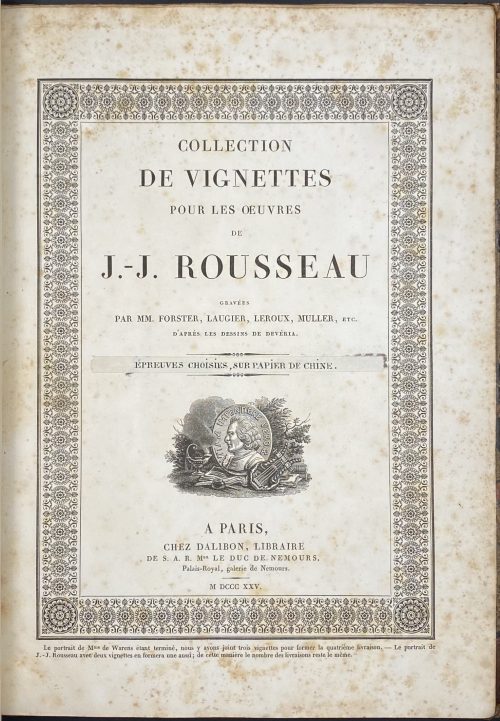 Pictorial album of 41 etchings, incl. two portraits, by various engravers after Achille Devéria, printed on India paper (after letters) and pasted on thick wove paper, bound with tissue guards in half calf over marbled boards bordered gilt, spine decorated gilt, marbled endpapers; base paper and tissue guards are substantially foxed, images mostly intact. The title page and the subscription page are bound-in at the beginning and at the end, respectively. Title page: (in ornamental frame): COLLECTION | DE VIGNETTES | POUR LES ŒUVRES | DE | J.-J. ROUSSEAU | GRAVÉES | PAR MM. FORSTER, LAUGIER, LEROUX, MULLER, ETC. | D'APRÈS LES DESSINS DE DEVÉRIA. | (pasted over) ÉPREUVES CHOISIES, SUR PAPIER DE CHINE. | {publisher’s device} | A PARIS, | CHEZ DALIBON, LIBRAIRE | DE S. A. R. MGR LE DUC DE NEMOURS, | Palais-Royal, galerie de Nemours. | M DCCC XXV. | Under the frame: Le portrait de Mme de Warens étant terminé, nous y avons joint trois vignettes pour former la quatrième livraison. — Le portrait de | J.-J. Rousseau avec deux vignettes en formera une aussi ; de cette manière le nombre des livraisons reste le même. || This collection was published by Dalibon the same year as the 25-volume Rousseau's Œuvres completes. Related persons: Jean-Jacques Rousseau (French, 1712 – 1778). Mme de Warens: Françoise-Louise de Warens [Louise Éléonore de la Tour du Pil] Swiss, 1699 – 1762). S.A.R. Mgr Le Duc de Nemours: Prince Louis of Orléans, Duke of Nemours [Louis Charles Philippe Raphaël d'Orléans] (French, 1814 – 1896). Contributors: François-Denis Dalibon (French, 1794 – 1853) – publisher. L'Imprimerie de Rignoux (Paris); Thomas-François Rignoux (1781 – 1863?) – printer. Achille Devéria (French, 1800 – 1857) – artist. Engravers : François Forster (French, 1790 – 1872) Jean Nicolas Laugier (French, 1785 – 1875) Jean Marie Leroux (French, 1788 – 1871) Henri Charles Müller (French, 1784 – 1845) Herbert König (German, 1820 – 1876) Louis Jean Désiré Delaistre (French, 1800 – 1871) Jean Louis Toussaint Caron (French, 1790 – 1832) Pierre Michel Adam (French, 1799 – 1853) Ferdinand Sébastien Goulu (French, 1796 – 1848) Jean-François Pourvoyeur (French, 1784 – 1851) Jean Baptiste Touzé (French, fl. 1810 – 1830) Narcisse Lecomte (French, 1794 – 1882) Louis Hercule Sisco (French, 1778 – 1861) Edme Jean Ruhierre (French, 1789 – fl. 1826) Auguste Thomas Marie Blanchard (French, 1819 – 1898) François Manceau (French, 1768 – after 1837) Gabriel Louis Lacour-Lestudier (French, 1800 – 1849) Fulley [Frilley?] Jean Jacques Frilley (French, 1797 – after 1850) Philippe Joseph Augustin Vallot (French, 1796 – 1870) Etienne Devilliers (French, 1784 – after 1844) Jean Bosq (French, fl. c. 1801 – 1844) Zachée Prévost (French, 1797 – 1861) Jean Baptiste Guyard II (French, 1787 – 1831/32) Antoine François Gelée (French, 1796-1860) Constant Louis Antoine Lorichon (French, 1800-1856?) Antoine Joseph Chollet (French, 1793 – after 1848) Adrien Migneret (French, 1786 – 1840) Alfred Johannot (French, 1800 – 1837) Arnold Jéhotte (French, 1789 – 1836) Hippolyte Prudhomme (French, 1793 – 1853) Achille Lefèvre (French, 1798 – 1864) Pierre Pelée (French, 1801 – 1871) Antoine [Tony] Johannot (French, 1803 – 1852) Pierre Joseph Tavernier (French, 1787 – after 1845) Leclerc (?) Levasseur (?)
Pictorial album of 41 etchings, incl. two portraits, by various engravers after Achille Devéria, printed on India paper (after letters) and pasted on thick wove paper, bound with tissue guards in half calf over marbled boards bordered gilt, spine decorated gilt, marbled endpapers; base paper and tissue guards are substantially foxed, images mostly intact. The title page and the subscription page are bound-in at the beginning and at the end, respectively. Title page: (in ornamental frame): COLLECTION | DE VIGNETTES | POUR LES ŒUVRES | DE | J.-J. ROUSSEAU | GRAVÉES | PAR MM. FORSTER, LAUGIER, LEROUX, MULLER, ETC. | D'APRÈS LES DESSINS DE DEVÉRIA. | (pasted over) ÉPREUVES CHOISIES, SUR PAPIER DE CHINE. | {publisher’s device} | A PARIS, | CHEZ DALIBON, LIBRAIRE | DE S. A. R. MGR LE DUC DE NEMOURS, | Palais-Royal, galerie de Nemours. | M DCCC XXV. | Under the frame: Le portrait de Mme de Warens étant terminé, nous y avons joint trois vignettes pour former la quatrième livraison. — Le portrait de | J.-J. Rousseau avec deux vignettes en formera une aussi ; de cette manière le nombre des livraisons reste le même. || This collection was published by Dalibon the same year as the 25-volume Rousseau's Œuvres completes. Related persons: Jean-Jacques Rousseau (French, 1712 – 1778). Mme de Warens: Françoise-Louise de Warens [Louise Éléonore de la Tour du Pil] Swiss, 1699 – 1762). S.A.R. Mgr Le Duc de Nemours: Prince Louis of Orléans, Duke of Nemours [Louis Charles Philippe Raphaël d'Orléans] (French, 1814 – 1896). Contributors: François-Denis Dalibon (French, 1794 – 1853) – publisher. L'Imprimerie de Rignoux (Paris); Thomas-François Rignoux (1781 – 1863?) – printer. Achille Devéria (French, 1800 – 1857) – artist. Engravers : François Forster (French, 1790 – 1872) Jean Nicolas Laugier (French, 1785 – 1875) Jean Marie Leroux (French, 1788 – 1871) Henri Charles Müller (French, 1784 – 1845) Herbert König (German, 1820 – 1876) Louis Jean Désiré Delaistre (French, 1800 – 1871) Jean Louis Toussaint Caron (French, 1790 – 1832) Pierre Michel Adam (French, 1799 – 1853) Ferdinand Sébastien Goulu (French, 1796 – 1848) Jean-François Pourvoyeur (French, 1784 – 1851) Jean Baptiste Touzé (French, fl. 1810 – 1830) Narcisse Lecomte (French, 1794 – 1882) Louis Hercule Sisco (French, 1778 – 1861) Edme Jean Ruhierre (French, 1789 – fl. 1826) Auguste Thomas Marie Blanchard (French, 1819 – 1898) François Manceau (French, 1768 – after 1837) Gabriel Louis Lacour-Lestudier (French, 1800 – 1849) Fulley [Frilley?] Jean Jacques Frilley (French, 1797 – after 1850) Philippe Joseph Augustin Vallot (French, 1796 – 1870) Etienne Devilliers (French, 1784 – after 1844) Jean Bosq (French, fl. c. 1801 – 1844) Zachée Prévost (French, 1797 – 1861) Jean Baptiste Guyard II (French, 1787 – 1831/32) Antoine François Gelée (French, 1796-1860) Constant Louis Antoine Lorichon (French, 1800-1856?) Antoine Joseph Chollet (French, 1793 – after 1848) Adrien Migneret (French, 1786 – 1840) Alfred Johannot (French, 1800 – 1837) Arnold Jéhotte (French, 1789 – 1836) Hippolyte Prudhomme (French, 1793 – 1853) Achille Lefèvre (French, 1798 – 1864) Pierre Pelée (French, 1801 – 1871) Antoine [Tony] Johannot (French, 1803 – 1852) Pierre Joseph Tavernier (French, 1787 – after 1845) Leclerc (?) Levasseur (?) -
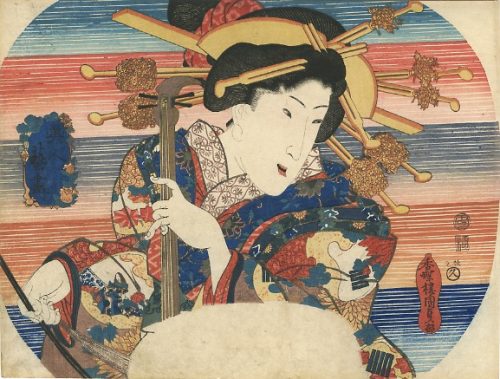 A young woman playing a four-string musical instrument with a bow (kokyū). Series: Assortments of Beauties Accomplishments [美人芸盡] (Bijin gei-zukushi). Utagawa Kunisada [歌川 国貞]; a.k.a. Utagawa Toyokuni III [三代歌川豊国] (Japanese, 1786 – 1865). Signed: Kochoro Kunisada ga [香蝶楼 国貞画] in a red double gourd cartouche. Publisher: Ibaya Kyūbei [伊場屋久兵衛] (Japanese, 1804 – 1851); seal: Hanmoto, Kyū [板元久] (Marks 19-040 | 126e) Date seal: Bunsei 12 (1829). Censors' seal: Kiwame. Size: Fan print (uchiwa-e).
A young woman playing a four-string musical instrument with a bow (kokyū). Series: Assortments of Beauties Accomplishments [美人芸盡] (Bijin gei-zukushi). Utagawa Kunisada [歌川 国貞]; a.k.a. Utagawa Toyokuni III [三代歌川豊国] (Japanese, 1786 – 1865). Signed: Kochoro Kunisada ga [香蝶楼 国貞画] in a red double gourd cartouche. Publisher: Ibaya Kyūbei [伊場屋久兵衛] (Japanese, 1804 – 1851); seal: Hanmoto, Kyū [板元久] (Marks 19-040 | 126e) Date seal: Bunsei 12 (1829). Censors' seal: Kiwame. Size: Fan print (uchiwa-e). -
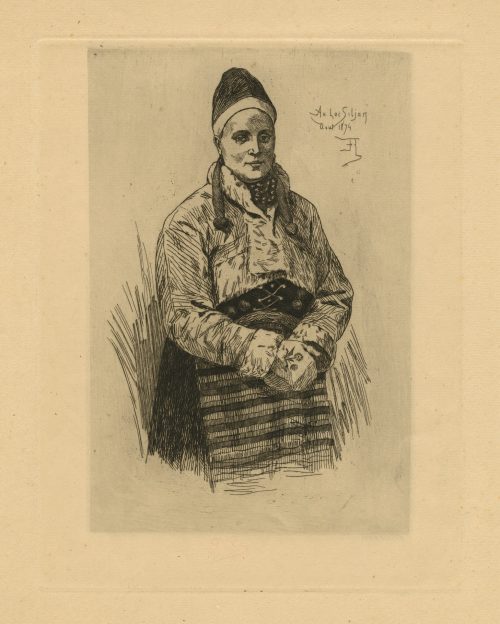
Etching on laid paper, monogrammed in the plate and inscribed "Au Lac Siljan, Août 1874". Owner's stamp LVM on verso.
Dimensions: Paper: 47 x 34 cm; Plate: 24 x 19 cm; Image: 21 x 14 cm.
Catalogue raisonné: Rouir 858:5; Arthur Hubschmid (1977): 320.
-
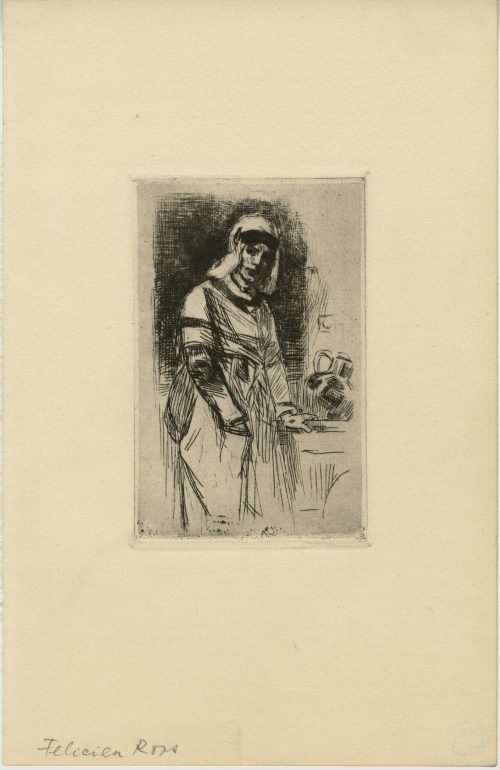
A woman from Antwerp or a servant, another title "Laitière anversoise"; 2nd state. Etching on wove paper. Owner's stamp LVM on verso.
Dimensions: Paper: 24.4 x 15.8 cm; Image: 12 x 7.5 cm
Catalogue raisonné: Arthur Hubschmid (1977): 343.
-
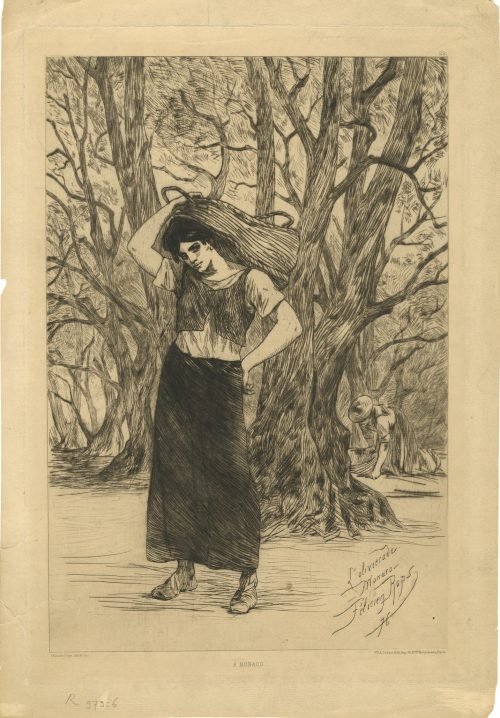
"In the olive grove", etching on laid paper. Signed on the plate and inscribed "L'olivierade Monaco, 76" (sic.). Owner's stamp LvM on verso.
Dimensions: Paper: 44 x 30.5 cm; Plate: 40 x 27 cm; Image: 35 x 24.5 cm.
Catalogue raisonné: Arthur Hubschmid (1977): 323; Graphics irreverent and erotic (1968): 323.
-
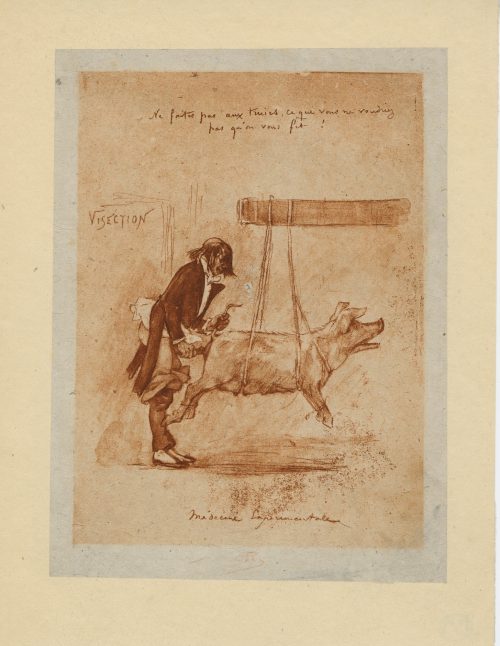
Sanguine print on toned China paper pasted on cream wove paper sheet, depicting a dressed-up man trying to copulate with a hanged sow. Inscription on top of the plate: "Ne faites pas aux truies ce que vous ne voudriez pas qu'on vous fit", and below: "Visection" (sic.). Owner's stamp 'LvM' on verso.
Dimensions: Paper: 26.8 x 20.6 cm; India paper: 21.5 x 16.2 cm; Image: 19.3 x 14.2 cm.
Catalogue raisonné: Arthur Hubschmid (1977): 661; Graphics irreverent and erotic (1968): 42.
-
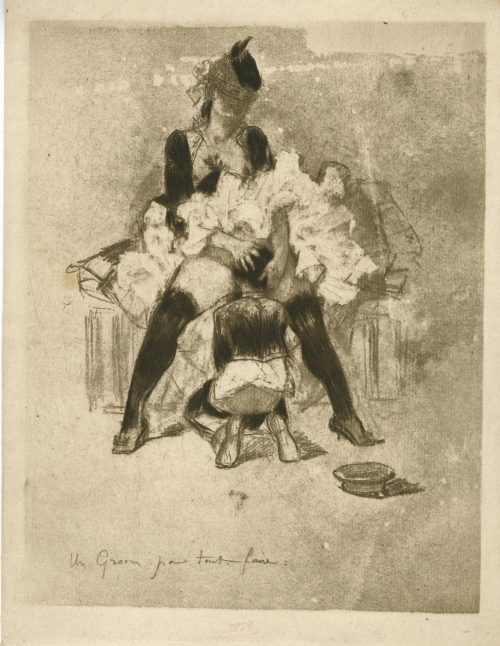
Etching on laid paper, depicting a kneeling groom with his head between the spread legs of a bare-breasted woman in a veiled hat. Inscribed on plate: Un groom a tout faire. Owner's stamp LVM on verso.
Dimensions: Paper: 24.4 x 15.8 cm; Image: 12 x 7.5 cm
Catalogue raisonné: Arthur Hubschmid (1977): 662.
-
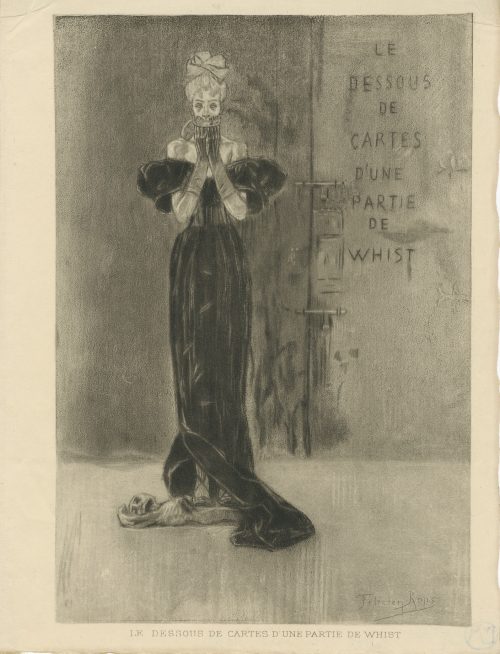
Soft-ground etching on laid paper. Inscribed on plate: "Le dessous de cartes d'une partie de whist" [The underside of a game of whist]. Owner's stamp 'LvM' on verso.
Dimensions: Paper: 26 x 20 cm; Image: 24 x 17.7 cm.
Catalogue raisonné: Arthur Hubschmid (1977): 43; Graphics irreverent and erotic (1968): 273.
-
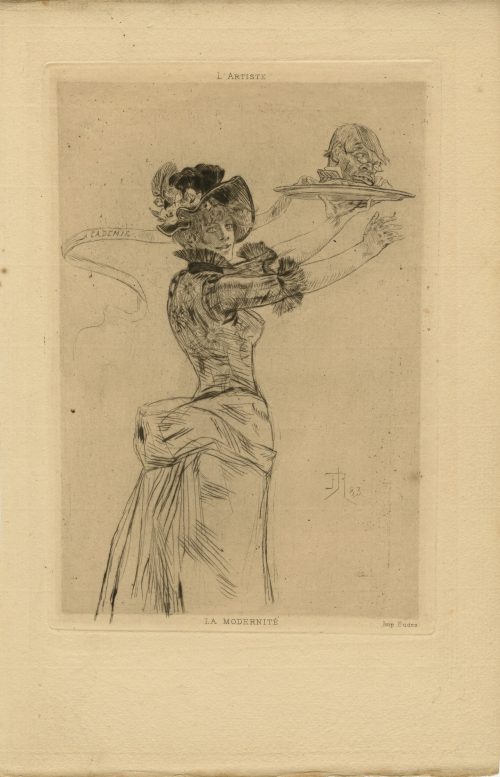
Drypoint on wove paper, depicting a woman in a hat with a ribbon lettered "ACADEMIE", carrying in her hand a male head in spectacles on a plate. Monogrammed "FR 83", inscribed: LA MODERNITÉ. — Imp. Eudes.; in pencil on verso."L'ARTISTE" – OCT. 1886 | (PRUD'HOMME ONTHOOFD) E 332-V". Owner's stamp 'LvM' on verso.
Dimensions: Paper: 27.2 x 17.8 cm; Plate: 19.7 x 14 cm; Image: 18.5 x 13 cm.
Catalogue raisonné: Rouir 767:5; Arthur Hubschmid (1977): 405; Graphics irreverent and erotic (1968): 72.
-
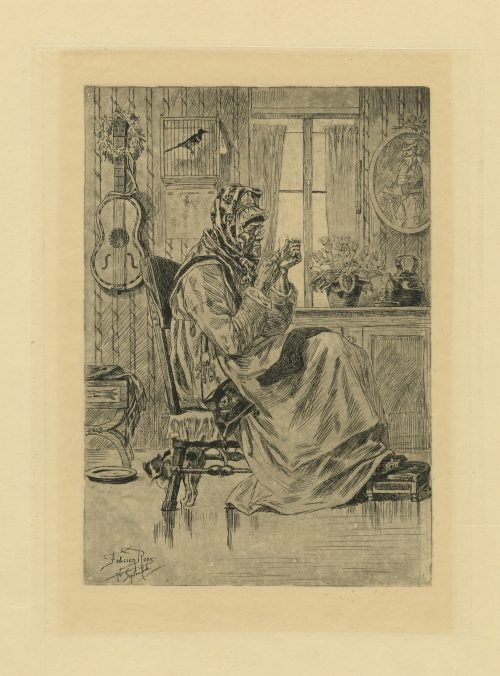
Etching on wove paper, depicting an old woman trying to thread a needle. Signed in plate: "Felicien Rops, 76 Septembre". Owner's stamp LvM on verso.
Dimensions: Paper: 51.9 x 35 cm; Plate: 27.5 x 21 cm; Image: 23.5 x 16 cm.
Catalogue raisonné: Arthur Hubschmid (1977): 358; Graphics irreverent and erotic (1968): 54.
-
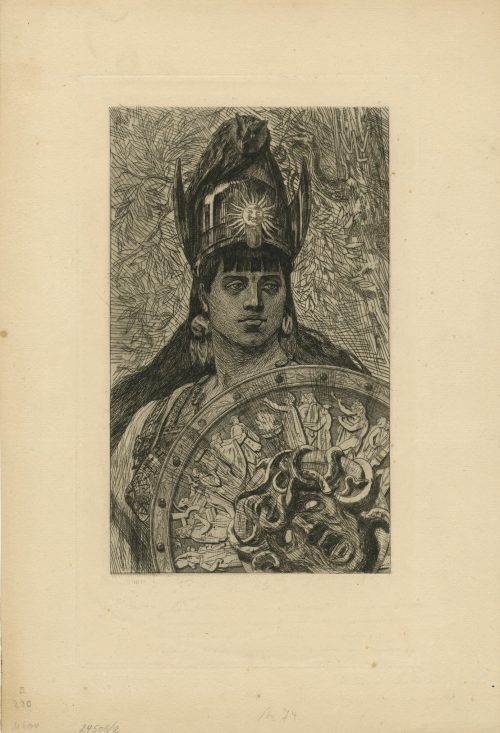
Etching and drypoint on wove paper, depicting Athena with an awl on her helmet and holding a shield with Medusa head. Owner's stamp 'LvM' on verso.
Dimensions: Paper: 38.7 x 26.5 cm; Plate: 31 x 18 cm; Image: 24.5 x 14.5 cm.
Catalogue raisonné: Arthur Hubschmid (1977): 317; Graphics irreverent and erotic (1968): 41.
-
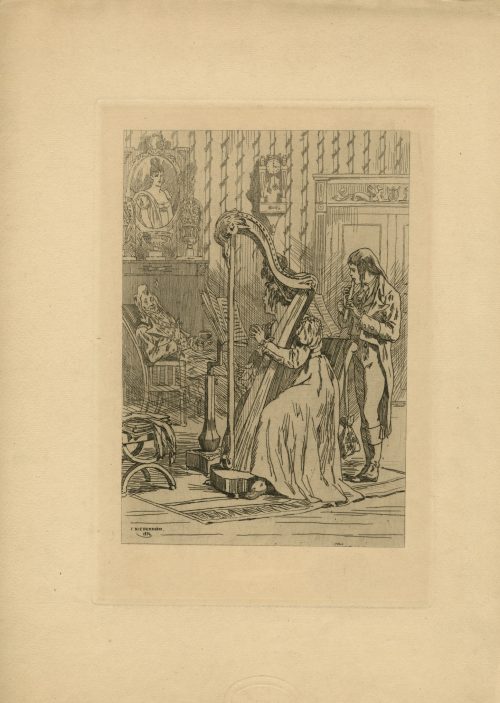
Two prints on laid paper, one in an earlier state, published under the name Niederkorn. Owner's stamp 'LvM' on verso.
Dimensions: Paper (1): 31 x 22.3 cm; Paper (2): 46 x 33.8 cm; Plate: 31 x 22 cm; Image: 25.5 x 17.5 cm.
Catalogue raisonné: Arthur Hubschmid (1977): 318; Rouir 954:3 and 954:5?.
-
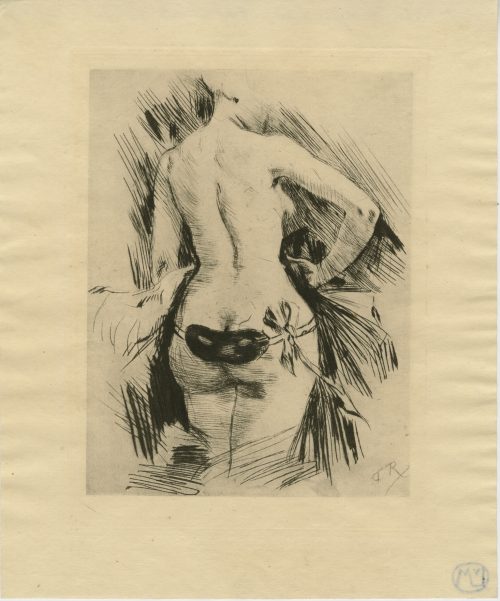
Etching and drypoint on wove paper, depicting a woman with a face mask on her buttocks. Monogrammed in the plate 'FR'. Owner's stamp 'LvM' on verso.
Dimensions: Papaer: 22.2 x 18.5 cm; Plate: 17.5 x 13.3 cm; Image: 15.5 x 12 cm.
Catalogue raisonné: Arthur Hubschmid (1977): 448; Graphics irreverent and erotic (1968): 106; Rouir 648.
-
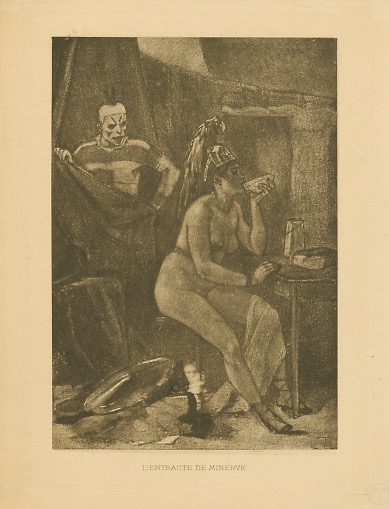
Photogravure after a pastel drawing by F. Rops. Monogrammed in the plate 'FR'. Owner's stamp 'LvM' on verso.
Dimensions: Paper: 26 x 20 cm; Plate: 25 x 18 cm; Image: 21 x 14.5 cm.
Catalogue raisonné: Arthur Hubschmid (1977): 543; Graphics irreverent and erotic (1968): 156.
-
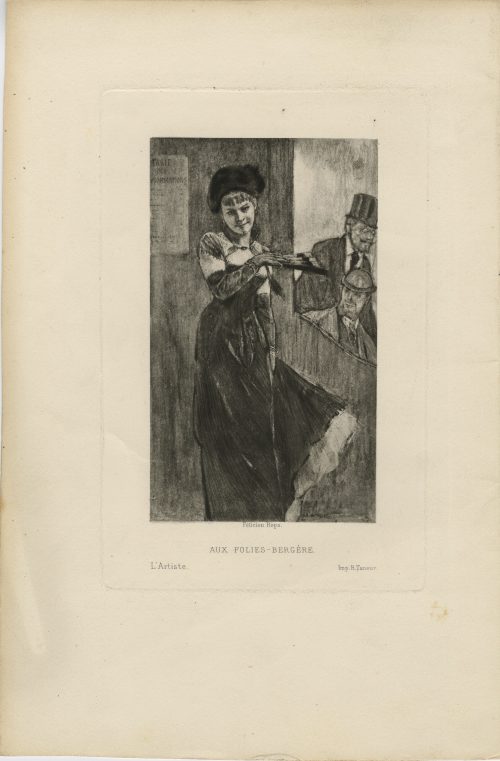
Aquatint finished by a drypoint on wove paper; printed by R. Taneur, depicting young woman in bar Folies Bergère in Paris. Signed in plate under image: "Félicien Rops | AUX FOLIES-BERGÈRE | L'Artiste. — Imp. R. Taneur. Owner's stamp 'LvM' on verso.
Dimensions: Paper: 26.7 x 17.6 cm; Plate: 17.5 x 11.5 cm; Image: 13.5 x 8 cm.
Catalogue raisonné: Graphics irreverent and erotic (1968): 125.
-
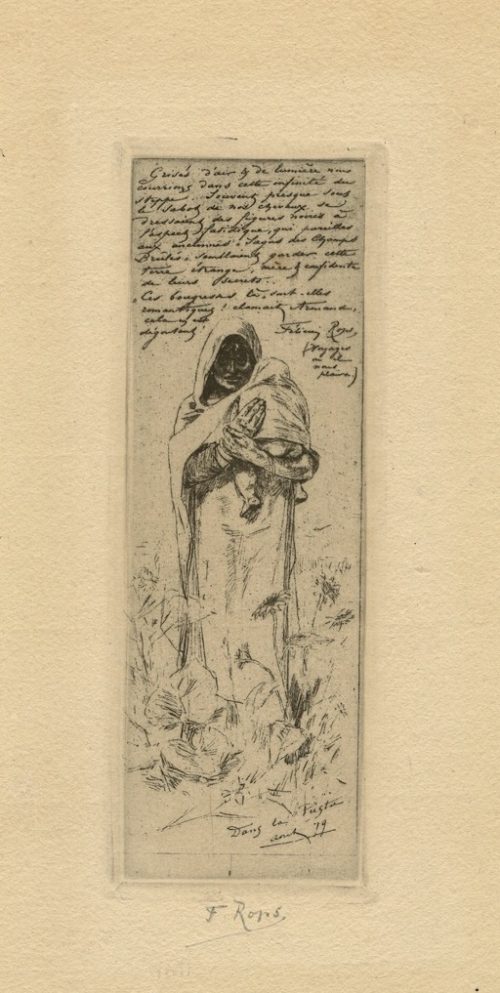
Etching and drypoint, signed in pencil by the artist under the plate; 2nd state. Pasted on a sheet of blue paper. Fragment of "La messe de Gnide". Owner's stamp 'LvM' on verso.
Dimensions: Blue paper: 32 x 27 cm; Laid paper: 30.7 x 22 cm; Image: 12.5 x 4 cm.
Catalogue raisonné: Arthur Hubschmid (1977): 364; Graphics irreverent and erotic (1968): 59; Rouir: 508.
-
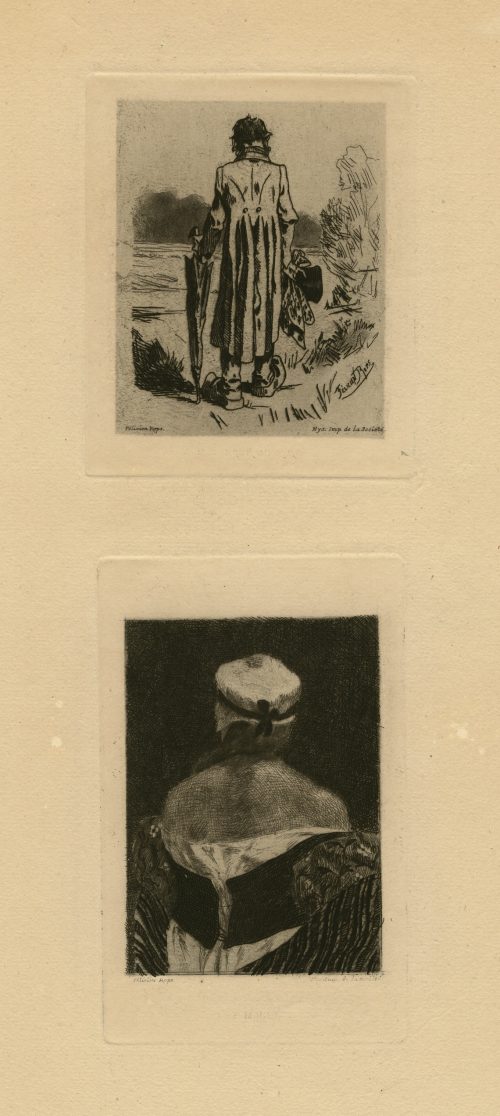
Two images printed on one sheet of van Gelder wove paper. Owner's stamp 'LvM' on verso.
Dimensions: Paper: 46.7 x 31 cm; top Mon bourgmestre: 11 x 9 cm plate, 9 x 7.5 cm image; Bottom Le modèle: 13.5 x 8.5 cm plate, 10 x 7 cm image.
Catalogue raisonné: Arthur Hubschmid (1977): 341 & 342; Rouir 425:4 & 517:7.
-
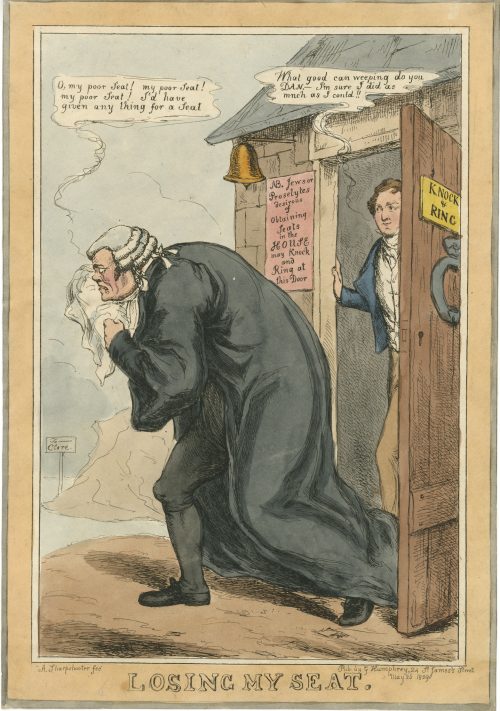 Hand-coloured etching by an anonymous British artist, printed on May 26, 1829, in London. Description by British Museum (1868,0808.8988): "O'Connell, in wig and gown, walks to the left from the massive door of a small stone building, stooping, and holding his handkerchief to his right eye. He wails: 'O, my poor Seat! my poor Seat! my poor Seat! I'd have given any thing for a seat.' In the doorway (right) stands Peel, saying with wary blandness: 'What good can weeping do you Dan.—I'm sure I did as much as I could!!' Above the large knocker on the plank door is 'Knock & Ring'. There is a projecting bell, above a placard: 'NB. Jews or Proselytes desirous of Obtaining Seats in the House may Knock and Ring at this Door.' One corner of "the House", a small stone shed, is depicted. O'Connell is walking towards a strip of water, across which is a mountain, with a board pointing 'To — Clare'. Comment by BM: "Catholic Emancipation raised high hopes among Jews; the first Bill, after a petition from Jews in Liverpool, was introduced 15 Apr. 1830, but Jewish Emancipation did not become law till 1858." Inscription under the frame with title, "A. Sharpshooter fec", text within image and publication line: "Pub. by G. Humphrey, 24 St. James's Street May 26 1829". Size: 37.5 x 26 cm.
Hand-coloured etching by an anonymous British artist, printed on May 26, 1829, in London. Description by British Museum (1868,0808.8988): "O'Connell, in wig and gown, walks to the left from the massive door of a small stone building, stooping, and holding his handkerchief to his right eye. He wails: 'O, my poor Seat! my poor Seat! my poor Seat! I'd have given any thing for a seat.' In the doorway (right) stands Peel, saying with wary blandness: 'What good can weeping do you Dan.—I'm sure I did as much as I could!!' Above the large knocker on the plank door is 'Knock & Ring'. There is a projecting bell, above a placard: 'NB. Jews or Proselytes desirous of Obtaining Seats in the House may Knock and Ring at this Door.' One corner of "the House", a small stone shed, is depicted. O'Connell is walking towards a strip of water, across which is a mountain, with a board pointing 'To — Clare'. Comment by BM: "Catholic Emancipation raised high hopes among Jews; the first Bill, after a petition from Jews in Liverpool, was introduced 15 Apr. 1830, but Jewish Emancipation did not become law till 1858." Inscription under the frame with title, "A. Sharpshooter fec", text within image and publication line: "Pub. by G. Humphrey, 24 St. James's Street May 26 1829". Size: 37.5 x 26 cm. -
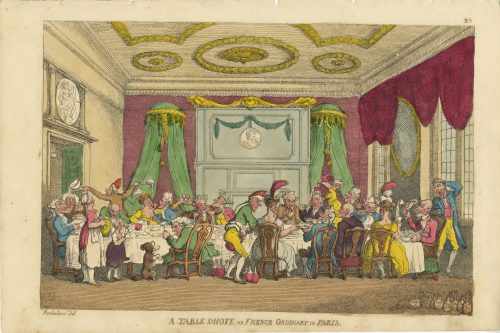 Hand-coloured etching by Thomas Rowlandson, printed on May 30, 1810, in London; № 20 from the series The Caricature Magazine or Hudibrastic Mirror Vol. 2. Description by Metropolitan Museum (59.533.978): "Guests of a dinner sit at a long narrow table in a magnificent room with an ornate ceiling. Two men and a young woman serve wine, one drawing a cork, the others spilling wine over the guests. Another waiter spills soup in an elderly guest's face. A woman and a little girl with a begging dog play tambourine and triangle at left." Inscribed in plate lower left: "Rowlandson Del."; bottom centre: "A TABLE DHOTE, OR FRENCH ORDINARY IN PARIS." Our copy is lacking the publication details: "Pub.d May 30. 1810 by Tho.s Tegg 111 Cheapside, London." and similar to the copy in Boston Public Library (18_03_000394). Dimensions: Sheet 27 x 40.5 cm; Image: 23.5 x 35 cm. Contributors: Thomas Rowlandson (British, 1756 – 1827) – artist. Thomas Tegg (British, 1776 – 1846) – publisher.
Hand-coloured etching by Thomas Rowlandson, printed on May 30, 1810, in London; № 20 from the series The Caricature Magazine or Hudibrastic Mirror Vol. 2. Description by Metropolitan Museum (59.533.978): "Guests of a dinner sit at a long narrow table in a magnificent room with an ornate ceiling. Two men and a young woman serve wine, one drawing a cork, the others spilling wine over the guests. Another waiter spills soup in an elderly guest's face. A woman and a little girl with a begging dog play tambourine and triangle at left." Inscribed in plate lower left: "Rowlandson Del."; bottom centre: "A TABLE DHOTE, OR FRENCH ORDINARY IN PARIS." Our copy is lacking the publication details: "Pub.d May 30. 1810 by Tho.s Tegg 111 Cheapside, London." and similar to the copy in Boston Public Library (18_03_000394). Dimensions: Sheet 27 x 40.5 cm; Image: 23.5 x 35 cm. Contributors: Thomas Rowlandson (British, 1756 – 1827) – artist. Thomas Tegg (British, 1776 – 1846) – publisher. -
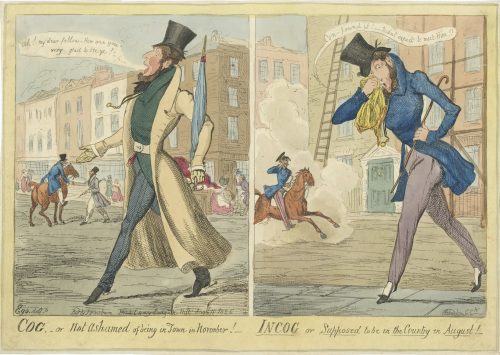 Description by British Museum (1865,1111.2128): "Two designs, side by side. [1] A dandy (probably a portrait), florid, whiskered, and bearded, steps jauntily from the pavement, hand extended, saying: Ah! my dear fellow — How are you? Devilish glad to see ye!— He holds a closed umbrella, ferrule erect, and wears a long tight-waisted coat to the heels, unbuttoned, tight pantaloons and spurred boots. In the middle distance, another dandy grasps the hand of a friend on horseback. Behind are houses with shop-fronts. A man raises his hat to a lady who curtseys. [2] The same dandy steps from the roadway onto the pavement, his handkerchief to his nose; he stoops, trying to conceal himself from a dandy cantering past in a cloud of dust, his eye-glass to his eye. He is without gloves, extraordinary for a dandy, and his trousers are strapped over pumps; he says: Con-found it! — Didn't expect to meet Him!! The street is otherwise empty; against the (large) houses are scaffolding and a tall ladder." Lettered with title, text within image including production details: 'Ego. delt / Etched by G. Ck / Pubd by J Fairburn Broadway Ludgate Hill August 18 1826'. Dimensions: Sheet: 25.5 x 36 cm, Image: 21.7 x 33.8 cm. Catalogue raisonné: A. M. Cohn (1924): № 1001, p. 262.: "A wretched plate. Difficult to believe G. C. had anything to do with it." — Bruton. Value.— £1.
Description by British Museum (1865,1111.2128): "Two designs, side by side. [1] A dandy (probably a portrait), florid, whiskered, and bearded, steps jauntily from the pavement, hand extended, saying: Ah! my dear fellow — How are you? Devilish glad to see ye!— He holds a closed umbrella, ferrule erect, and wears a long tight-waisted coat to the heels, unbuttoned, tight pantaloons and spurred boots. In the middle distance, another dandy grasps the hand of a friend on horseback. Behind are houses with shop-fronts. A man raises his hat to a lady who curtseys. [2] The same dandy steps from the roadway onto the pavement, his handkerchief to his nose; he stoops, trying to conceal himself from a dandy cantering past in a cloud of dust, his eye-glass to his eye. He is without gloves, extraordinary for a dandy, and his trousers are strapped over pumps; he says: Con-found it! — Didn't expect to meet Him!! The street is otherwise empty; against the (large) houses are scaffolding and a tall ladder." Lettered with title, text within image including production details: 'Ego. delt / Etched by G. Ck / Pubd by J Fairburn Broadway Ludgate Hill August 18 1826'. Dimensions: Sheet: 25.5 x 36 cm, Image: 21.7 x 33.8 cm. Catalogue raisonné: A. M. Cohn (1924): № 1001, p. 262.: "A wretched plate. Difficult to believe G. C. had anything to do with it." — Bruton. Value.— £1. -
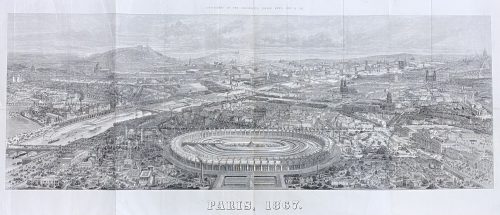
Lithography on paper by Charles Fichot (French, 1817 – 1903), published in a supplement to the Illustrated London News of July 6, 1867.
The construction on the foreground is the International Exposition of 1867 (Exposition universelle d'art et d'industrie de 1867). Dimensions: Sheet: 130 x 58 cm; Image: 118 x 43 cm. -
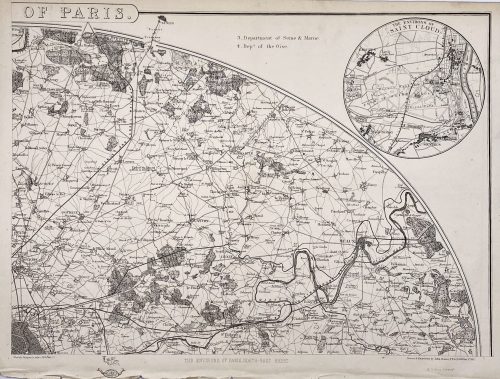 Four maps 34 x 47.5 cm each. Include insets of Versailles, Fontainebleau, Saint Cloud and St. Germain en Laye. Lithograph by Edward Weller after a map drawn and engraved by John Dower. "These maps originally appeared in the Weekly Dispatch newspaper from 1856 to 1862. They were reissued between 1863 and 1867 by Cassell, Petter and Galpin and then published collectively as Cassell's Atlas. The plates were acquired by G.W. Bacon & Co., and reissued in 1876 under the title Bacon's New Quarto Atlas ... of the Counties of England, and many times since under various titles." [WorldCat]
Four maps 34 x 47.5 cm each. Include insets of Versailles, Fontainebleau, Saint Cloud and St. Germain en Laye. Lithograph by Edward Weller after a map drawn and engraved by John Dower. "These maps originally appeared in the Weekly Dispatch newspaper from 1856 to 1862. They were reissued between 1863 and 1867 by Cassell, Petter and Galpin and then published collectively as Cassell's Atlas. The plates were acquired by G.W. Bacon & Co., and reissued in 1876 under the title Bacon's New Quarto Atlas ... of the Counties of England, and many times since under various titles." [WorldCat]Dimensions: 34 x 47.5 cm each.
Contributors: Weller, Edward (British, 1819 – 1884) – lithographer. Dower, John Crane (British, 1791 – 1847) – artist, engraver. Dower, John James (British, 1825 – 1901) – artist, engraver (son of John Crane Dower). -
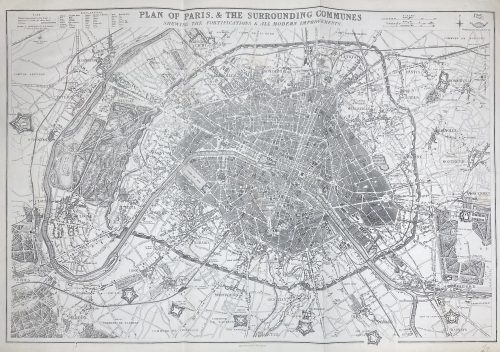 PLAN OF PARIS & THE SURROUNDING COMMUNES | SHEWING THE FORTIFICATIONS & ALL MODERN IMPROVEMENTS. || Lettered above the image with title, and below with production detail: "Day & Son, Lithrs to the Queen"; and production detail above: "Drawn & Engraved by B.R. Davies: / 16 George Str Euston Squ London", and on top right: "Weekly Dispatch Atlas, 138 Fleet Str". Dimensions: 47.5 x 65.4 cm. Contributors: Day & Son; William Day (British, 1797 – 1845) – lithographer, printer. Davies, Benjamin Rees (British, 1789 – 1872) – artist, engraver.
PLAN OF PARIS & THE SURROUNDING COMMUNES | SHEWING THE FORTIFICATIONS & ALL MODERN IMPROVEMENTS. || Lettered above the image with title, and below with production detail: "Day & Son, Lithrs to the Queen"; and production detail above: "Drawn & Engraved by B.R. Davies: / 16 George Str Euston Squ London", and on top right: "Weekly Dispatch Atlas, 138 Fleet Str". Dimensions: 47.5 x 65.4 cm. Contributors: Day & Son; William Day (British, 1797 – 1845) – lithographer, printer. Davies, Benjamin Rees (British, 1789 – 1872) – artist, engraver. -
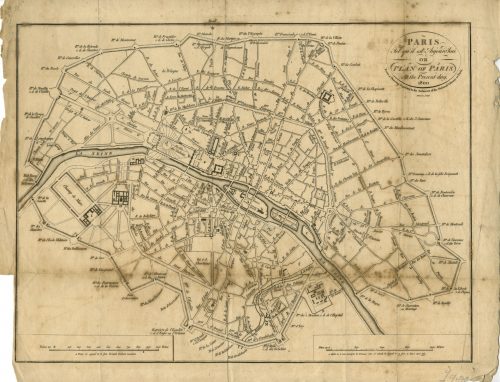 Title: PARIS | Tel qu'il est Aujourd'hui | OR | PLAN OF PARIS | At the Present day. 1800 | From a Drawing deposited in the Archieves of the National Library at Paris | Menzies sculpt. || Contributor: Menzies, John (British, fl. c. 1792 – 1851) – engraver. Ref: Gallica.
Title: PARIS | Tel qu'il est Aujourd'hui | OR | PLAN OF PARIS | At the Present day. 1800 | From a Drawing deposited in the Archieves of the National Library at Paris | Menzies sculpt. || Contributor: Menzies, John (British, fl. c. 1792 – 1851) – engraver. Ref: Gallica. -
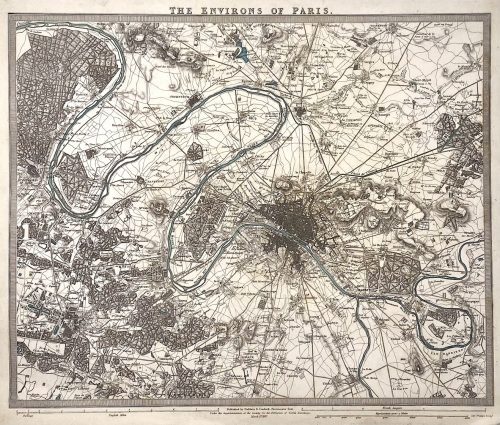 Top: THE ENVIRONS OF PARIS. || Bottom centre: Published by Baldwin & Cradock, Paternoster Row, | Under the Superintendence of the Society for the Diffusion of Useful Knowledge. | March 1st. 1832. || Bottom right: J. & C. Walker sculpt. || Dimensions: Sheet: 34.7 x 40.5 cm; Image: 30 x 37 cm. Contributors: J & C Walker (British firm, fl. 1820 – 1895) Walker, John (British, 1787 – 1873) Walker, Alexander (British, 1797? – 1870) Walker, Charles (British, 1799? – 1872) Society for the Diffusion of Useful Knowledge (SDUK) (British firm, 1826 – 1846)
Top: THE ENVIRONS OF PARIS. || Bottom centre: Published by Baldwin & Cradock, Paternoster Row, | Under the Superintendence of the Society for the Diffusion of Useful Knowledge. | March 1st. 1832. || Bottom right: J. & C. Walker sculpt. || Dimensions: Sheet: 34.7 x 40.5 cm; Image: 30 x 37 cm. Contributors: J & C Walker (British firm, fl. 1820 – 1895) Walker, John (British, 1787 – 1873) Walker, Alexander (British, 1797? – 1870) Walker, Charles (British, 1799? – 1872) Society for the Diffusion of Useful Knowledge (SDUK) (British firm, 1826 – 1846) -
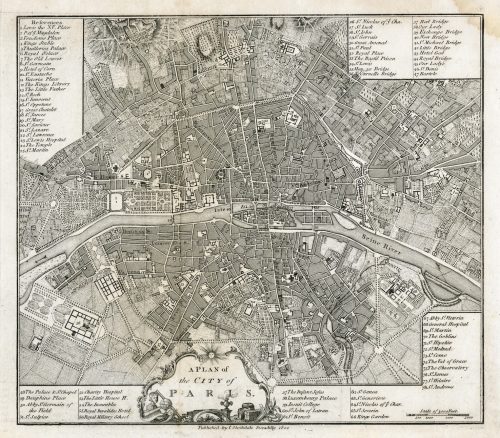 In pictorial frame: A PLAN of | the CITY of PARIS. || Under the border: Published by I. Stockdale Piccadilly 1800 || Dimensions: Sheet: 29 x 34.5 cm; Image: 22.7 x 25.9 cm.
In pictorial frame: A PLAN of | the CITY of PARIS. || Under the border: Published by I. Stockdale Piccadilly 1800 || Dimensions: Sheet: 29 x 34.5 cm; Image: 22.7 x 25.9 cm. -
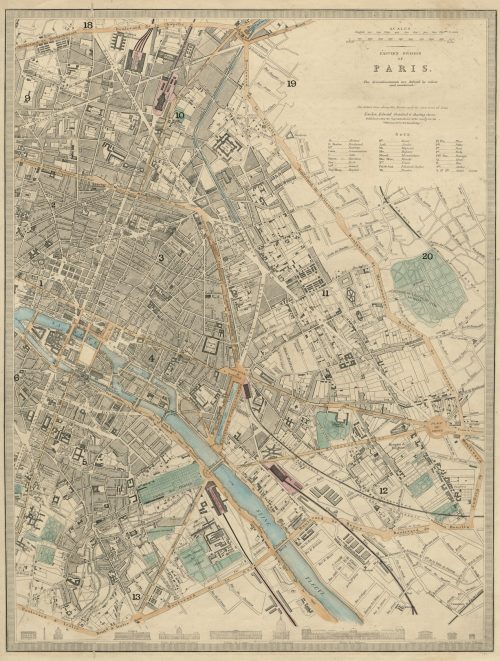 EASTERN DIVISION | OF | PARIS. | The Arrondissements are defined by colour | and numbered. || London, Edward Stanford 6 Charing Cross. | Published under the Superintendence of the Society for the Diffusion of Useful Knowledge. || Dimensions: Sheet: 43.5 x 35.5 cm; Image: 39.5 x 30 cm. Contributors: Edward Stanford (British, 1827 – 1904) – cartographer, engraver, publisher. Society for the Diffusion of Useful Knowledge (SDUK) (British firm, 1826 – 1846).
EASTERN DIVISION | OF | PARIS. | The Arrondissements are defined by colour | and numbered. || London, Edward Stanford 6 Charing Cross. | Published under the Superintendence of the Society for the Diffusion of Useful Knowledge. || Dimensions: Sheet: 43.5 x 35.5 cm; Image: 39.5 x 30 cm. Contributors: Edward Stanford (British, 1827 – 1904) – cartographer, engraver, publisher. Society for the Diffusion of Useful Knowledge (SDUK) (British firm, 1826 – 1846). -
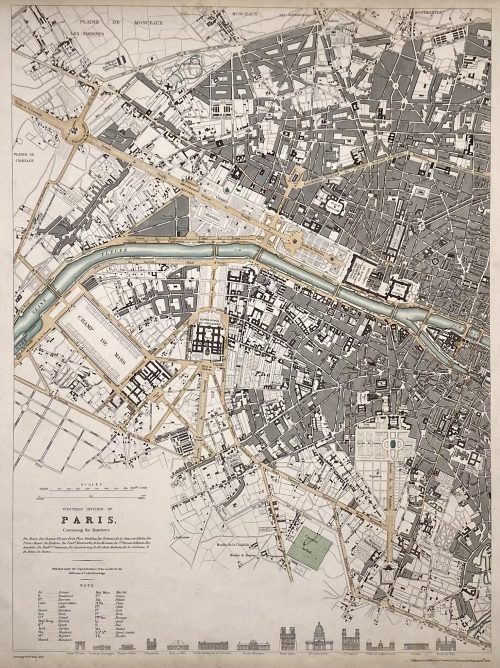 WESTERN DIVISION OF | PARIS. | Containing the Quartiers | {4 lines in italic} | Published under the Superintendence of the Society for the | Diffusion of Useful Knowledge || Under the frame: Drawn by W. B. Clarke, Archt. […] Published by Baldwin & Cradock, 47 Paternoster Row, April 1st. 1834. Dimensions: Sheet: 40.5 x 34.5 cm; Image: 39 x 28.8 cm. Contributors: William Barnard Clarke (British, 1806 – 1865) – artist. John Shury (fl. c. 1814-1844) – engraver. Baldwin & Cradock (London) – publisher. Society for the Diffusion of Useful Knowledge (SDUK) (British firm, 1826 – 1846).
WESTERN DIVISION OF | PARIS. | Containing the Quartiers | {4 lines in italic} | Published under the Superintendence of the Society for the | Diffusion of Useful Knowledge || Under the frame: Drawn by W. B. Clarke, Archt. […] Published by Baldwin & Cradock, 47 Paternoster Row, April 1st. 1834. Dimensions: Sheet: 40.5 x 34.5 cm; Image: 39 x 28.8 cm. Contributors: William Barnard Clarke (British, 1806 – 1865) – artist. John Shury (fl. c. 1814-1844) – engraver. Baldwin & Cradock (London) – publisher. Society for the Diffusion of Useful Knowledge (SDUK) (British firm, 1826 – 1846). -
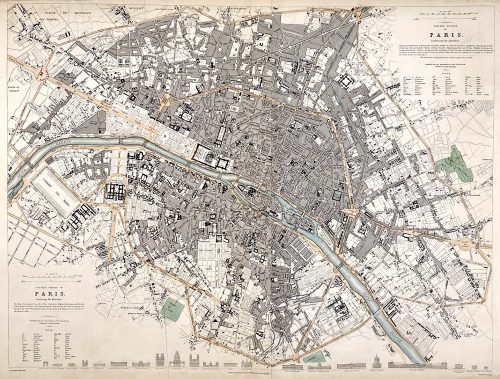 Top right: EASTERN DIVISION OF | PARIS. | Containing the Quartiers | {5 lines in italic} | Published under the Superintendence of the Society for the | Diffusion of Useful Knowledge || Bottom left: WESTERN DIVISION OF | PARIS. | Containing the Quartiers | {4 lines in italic} | Published under the Superintendence of the Society for the | Diffusion of Useful Knowledge || Under the frame: Drawn by W. B. Clarke, Archt. […] London: Published by Chapman and Hall, 186, Strand. April 1st, 1834. [...] Engraved by J. Shury || Dimensions: Sheet: 40.8 x 57 cm; Image: 38.7 x 52.5 cm. Contributors: William Barnard Clarke (British, 1806 – 1865) – artist. John Shury (fl. c. 1814-1844) – engraver. Chapman and Hall (London) – publisher. Society for the Diffusion of Useful Knowledge (SDUK) (British firm, 1826 – 1846).
Top right: EASTERN DIVISION OF | PARIS. | Containing the Quartiers | {5 lines in italic} | Published under the Superintendence of the Society for the | Diffusion of Useful Knowledge || Bottom left: WESTERN DIVISION OF | PARIS. | Containing the Quartiers | {4 lines in italic} | Published under the Superintendence of the Society for the | Diffusion of Useful Knowledge || Under the frame: Drawn by W. B. Clarke, Archt. […] London: Published by Chapman and Hall, 186, Strand. April 1st, 1834. [...] Engraved by J. Shury || Dimensions: Sheet: 40.8 x 57 cm; Image: 38.7 x 52.5 cm. Contributors: William Barnard Clarke (British, 1806 – 1865) – artist. John Shury (fl. c. 1814-1844) – engraver. Chapman and Hall (London) – publisher. Society for the Diffusion of Useful Knowledge (SDUK) (British firm, 1826 – 1846). -
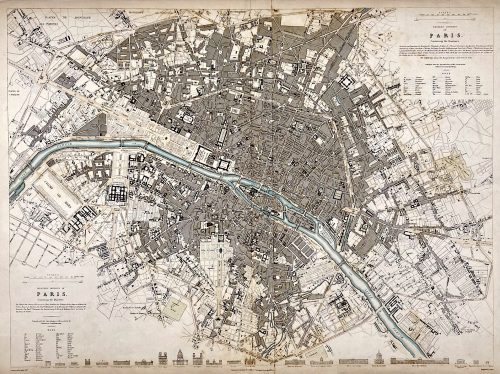 Top right: EASTERN DIVISION OF | PARIS. | Containing the Quartiers | {5 lines in italic} | Published under the Superintendence of the Society for the | Diffusion of Useful Knowledge || Bottom left: WESTERN DIVISION OF | PARIS. | Containing the Quartiers | {4 lines in italic} | Published under the Superintendence of the Society for the | Diffusion of Useful Knowledge || Under the frame: Drawn by W. B. Clarke, Archt. […] Published by Baldwin & Cradock, 47 Paternoster Row, A April 1st, 1834. [...] Engraved by J. Shury || Dimensions: Sheet: 40.8 x 57 cm; Image: 38.7 x 52.5 cm. Contributors: William Barnard Clarke (British, 1806 – 1865) – artist. John Shury (fl. c. 1814-1844) – engraver. Baldwin & Cradock (London) – publisher. Society for the Diffusion of Useful Knowledge (SDUK) (British firm, 1826 – 1846).
Top right: EASTERN DIVISION OF | PARIS. | Containing the Quartiers | {5 lines in italic} | Published under the Superintendence of the Society for the | Diffusion of Useful Knowledge || Bottom left: WESTERN DIVISION OF | PARIS. | Containing the Quartiers | {4 lines in italic} | Published under the Superintendence of the Society for the | Diffusion of Useful Knowledge || Under the frame: Drawn by W. B. Clarke, Archt. […] Published by Baldwin & Cradock, 47 Paternoster Row, A April 1st, 1834. [...] Engraved by J. Shury || Dimensions: Sheet: 40.8 x 57 cm; Image: 38.7 x 52.5 cm. Contributors: William Barnard Clarke (British, 1806 – 1865) – artist. John Shury (fl. c. 1814-1844) – engraver. Baldwin & Cradock (London) – publisher. Society for the Diffusion of Useful Knowledge (SDUK) (British firm, 1826 – 1846). -
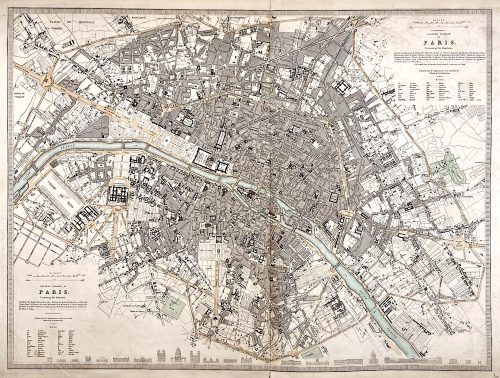 Top right: EASTERN DIVISION OF | PARIS. | Containing the Quartiers | {5 lines in italic} | Published under the Superintendence of the Society for the | Diffusion of Useful Knowledge || Bottom left: WESTERN DIVISION OF | PARIS. | Containing the Quartiers | {4 lines in italic} | Published under the Superintendence of the Society for the | Diffusion of Useful Knowledge || The map is framed, but there is no lettering beneath the frame to identify the cartographer, engraver, and publisher. However, we can attribute it to William Barnard Clarke (British, 1806 – 1865) and John Shury (fl. c. 1814-1844). The publisher is either Baldwin & Cradock or Chapman and Hall. Dimensions: Sheet: 40 x 60.8 cm; Image: 40 x 53.5 cm.
Top right: EASTERN DIVISION OF | PARIS. | Containing the Quartiers | {5 lines in italic} | Published under the Superintendence of the Society for the | Diffusion of Useful Knowledge || Bottom left: WESTERN DIVISION OF | PARIS. | Containing the Quartiers | {4 lines in italic} | Published under the Superintendence of the Society for the | Diffusion of Useful Knowledge || The map is framed, but there is no lettering beneath the frame to identify the cartographer, engraver, and publisher. However, we can attribute it to William Barnard Clarke (British, 1806 – 1865) and John Shury (fl. c. 1814-1844). The publisher is either Baldwin & Cradock or Chapman and Hall. Dimensions: Sheet: 40 x 60.8 cm; Image: 40 x 53.5 cm. -
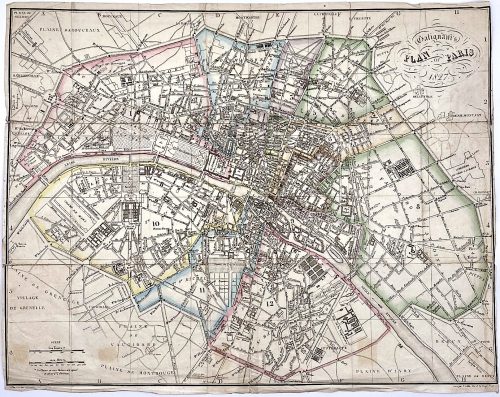 Upper right: Galignani's | PLAN OF PARIS | 1827 || in oval frame: Sauve sculpt. Bottom, under the frame: le Plan écrit par Lallemand. […] Gravé par E. Collin. Rue de la Harpe № 45. Dimensions: 36.5 x 46.5 cm. Armand Joseph Lallemand (French, c. 1810 - 1871) – cartographer. Charles-Étienne Collin (French, 1770 – 1840) – engraver. Étienne Collin II (French,1790 – 1852) – engraver. John Anthony Galignani (Italian, 1796 – 1873) – publisher. William Galignani (Italian, 1798 – 1882) – publisher.
Upper right: Galignani's | PLAN OF PARIS | 1827 || in oval frame: Sauve sculpt. Bottom, under the frame: le Plan écrit par Lallemand. […] Gravé par E. Collin. Rue de la Harpe № 45. Dimensions: 36.5 x 46.5 cm. Armand Joseph Lallemand (French, c. 1810 - 1871) – cartographer. Charles-Étienne Collin (French, 1770 – 1840) – engraver. Étienne Collin II (French,1790 – 1852) – engraver. John Anthony Galignani (Italian, 1796 – 1873) – publisher. William Galignani (Italian, 1798 – 1882) – publisher. -
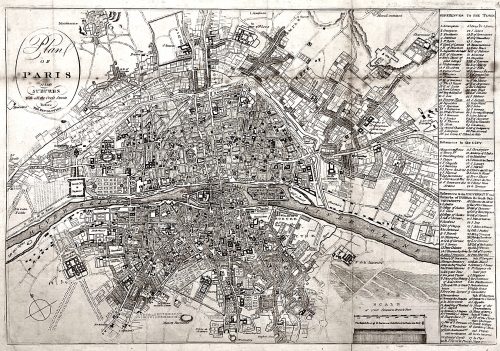 Oval cartouche in the upper-left corner, with tall “s”: Plan | OF | PARIS | and | SUBURBS | With all the Cross Streets | Before | THE REVOLUTION. || No indication of the makers. Dimensions: Sheet: 32.5 x 44.3 cm; Image: 28.5 x 41.3 cm.
Oval cartouche in the upper-left corner, with tall “s”: Plan | OF | PARIS | and | SUBURBS | With all the Cross Streets | Before | THE REVOLUTION. || No indication of the makers. Dimensions: Sheet: 32.5 x 44.3 cm; Image: 28.5 x 41.3 cm. -
 London: Published under the superintendence of the Society for the Diffusion of Useful Knowledge; Charles Knight & Co., no. 22 Ludgate Street. Dimensions: Sheet: 34 x 41.8 cm: Image: 28.7 x 38.3 cm. J. & C. Walker, Society for the Diffusion of Useful Knowledge Charles Knight & Co.; Charles Knight (British, 1791 – 1873) – publisher. J & C Walker (British firm, fl. 1820 – 1895) Walker, John (British, 1787 – 1873) Walker, Alexander (British, 1797? – 1870) Walker, Charles (British, 1799? – 1872) Society for the Diffusion of Useful Knowledge (SDUK) (British firm, 1826 – 1846)
London: Published under the superintendence of the Society for the Diffusion of Useful Knowledge; Charles Knight & Co., no. 22 Ludgate Street. Dimensions: Sheet: 34 x 41.8 cm: Image: 28.7 x 38.3 cm. J. & C. Walker, Society for the Diffusion of Useful Knowledge Charles Knight & Co.; Charles Knight (British, 1791 – 1873) – publisher. J & C Walker (British firm, fl. 1820 – 1895) Walker, John (British, 1787 – 1873) Walker, Alexander (British, 1797? – 1870) Walker, Charles (British, 1799? – 1872) Society for the Diffusion of Useful Knowledge (SDUK) (British firm, 1826 – 1846) -
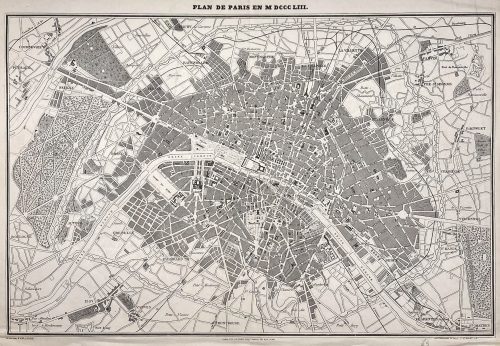 Above the frame: PLAN DE PARIS EN MDCCCLIII. Below the frame: Gravé par F. DELAMARE […] PARIS. TYP. DE FIRMIN DIDOT FRÈRES, 56, RUE JACOB. […] PANICONOGRAPHIE DE GILLOT. Q. ST. MICHEL 23. Dimensions: Sheet: 37 x 52.5 cm: Image: 33 x 50 cm. Technique: Photozincography Contributors: Ferdinand Théodore Delamare (French, fl. 1850 – 1889) – engraver. Firmin Didot Frères ; Firmin Didot (French, 1764 – 1836) – publisher. Firmin Gillot (French, 1819 – 1872) – printer.
Above the frame: PLAN DE PARIS EN MDCCCLIII. Below the frame: Gravé par F. DELAMARE […] PARIS. TYP. DE FIRMIN DIDOT FRÈRES, 56, RUE JACOB. […] PANICONOGRAPHIE DE GILLOT. Q. ST. MICHEL 23. Dimensions: Sheet: 37 x 52.5 cm: Image: 33 x 50 cm. Technique: Photozincography Contributors: Ferdinand Théodore Delamare (French, fl. 1850 – 1889) – engraver. Firmin Didot Frères ; Firmin Didot (French, 1764 – 1836) – publisher. Firmin Gillot (French, 1819 – 1872) – printer. -
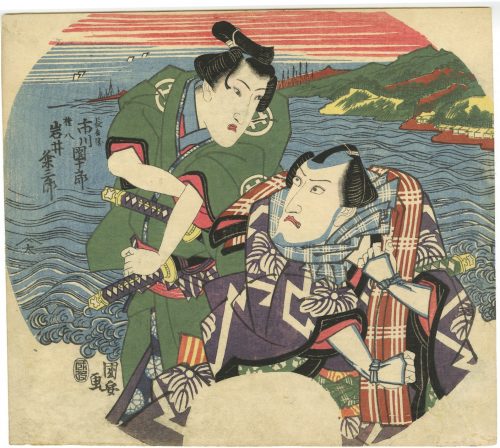 Artist: Utagawa Kuniyasu [歌川 国安] (Japanese, 1794–1832). Publisher seal: [太] (Ta): Marks 02-050 | U421b: An unknown publisher in Edo, fl. c. 1815-61; name assigned according to seal shape “Yama-Ta“. Signed: Kuniyasu ga [国安 画]. Date-aratame seal: Bunsei 9 (1826). Actors: Iwai Hanshirō VI [岩井半四郎] (Japanese, 1799 – 1836), other names: Iwai Hanshirō VI, Iwai Kumesaburō II, Iwai Hisajirō I, Baiga (poetry name), Shūka (poetry name) — as Shirai Gonpachi [白井權八]. Ichikawa Danjūrō VII 市川団十郎 (Japanese, 1791 – 1859), other names: Ichikawa Ebizō V, Ichikawa Hakuen II, Ichikawa Shinnosuke I — as Banzui Chōbei [幡随長兵衛]. Kabuki play: Suzugamori [Suzu-ga-Mori, 鈴ヶ森], a.k.a. Ukiyozuka Hiyoku no Inazuma written by Tsuruya Nanboku IV (Japanese, c. 1755 – 1829). First staged in 1823 at Ichimura-za [市村座] in Edo. Plot: "A gang of evil palanquin bearers are stationed near the Suzugamori execution grounds, where they lay in wait to rob travellers passing through. Gonpachi, who killed a man in his home province, is being sought by the police. He is fleeing to Edo when the bearers attack him in hopes of claiming a reward. He beats them off with great skill. Banzui Chōbei, who is being carried by in a palanquin, sees the attack, admires Gonpachi's ability, and promises to aid him if he is going to Edo". [Samuel L. Leiter. Historical Dictionary of Japanese Traditional Theatre. — Rowman & Littlefield, 2014; p. 382-3.; LIB-2110.2019]. Ref.: Sotheby's.
Artist: Utagawa Kuniyasu [歌川 国安] (Japanese, 1794–1832). Publisher seal: [太] (Ta): Marks 02-050 | U421b: An unknown publisher in Edo, fl. c. 1815-61; name assigned according to seal shape “Yama-Ta“. Signed: Kuniyasu ga [国安 画]. Date-aratame seal: Bunsei 9 (1826). Actors: Iwai Hanshirō VI [岩井半四郎] (Japanese, 1799 – 1836), other names: Iwai Hanshirō VI, Iwai Kumesaburō II, Iwai Hisajirō I, Baiga (poetry name), Shūka (poetry name) — as Shirai Gonpachi [白井權八]. Ichikawa Danjūrō VII 市川団十郎 (Japanese, 1791 – 1859), other names: Ichikawa Ebizō V, Ichikawa Hakuen II, Ichikawa Shinnosuke I — as Banzui Chōbei [幡随長兵衛]. Kabuki play: Suzugamori [Suzu-ga-Mori, 鈴ヶ森], a.k.a. Ukiyozuka Hiyoku no Inazuma written by Tsuruya Nanboku IV (Japanese, c. 1755 – 1829). First staged in 1823 at Ichimura-za [市村座] in Edo. Plot: "A gang of evil palanquin bearers are stationed near the Suzugamori execution grounds, where they lay in wait to rob travellers passing through. Gonpachi, who killed a man in his home province, is being sought by the police. He is fleeing to Edo when the bearers attack him in hopes of claiming a reward. He beats them off with great skill. Banzui Chōbei, who is being carried by in a palanquin, sees the attack, admires Gonpachi's ability, and promises to aid him if he is going to Edo". [Samuel L. Leiter. Historical Dictionary of Japanese Traditional Theatre. — Rowman & Littlefield, 2014; p. 382-3.; LIB-2110.2019]. Ref.: Sotheby's. -
 Title: On the Banks of the Kamo River [加茂堤] (Kamo Tsutsumi), sometimes transcribed as Kamo Zutsumi. Series: A Parody of Sugawara [美立菅原] (Mitate Sugawara). The word mitate is usually written as 見立 but here it is 美立, like on another Kunisada's fan print A beauty reading a book on a balcony overlooking a bay: A Parody of Sugawara Stripes (see SVJP-0334.2021 in this collection). On the Banks of the Kamo River is a scene from the play Sugawara's Secrets of Calligraphy [菅原伝授手習鑑] (Sugawara Denju Tenarai Kagami); it was originally written for the puppet theatre (Bunraku) and staged for the first time in the 8th lunar month of 1746 in Ôsaka at the Takemotoza. It was adapted for Kabuki the following month and staged for the first time in Kyôto at the Kitagawa no Shibai, produced by Nakamura Kiyosaburô I. It was also performed for the first time in Edo, at the Ichimuraza, in the 3rd lunar month of 1747. The shape of the cartouche resembles an ox cart viewed from the back which alludes to the scene Fighting for the Carriage (Kuruma biki). Artist: Utagawa Kunisada [歌川 国貞] a.k.a. Utagawa Toyokuni III [三代 歌川 豊国] (Japanese, 1786 – 1865). Signed: Toyokuni [豊国] in a red toshidama cartouche. The character ga [画] is missing (cut out). Publisher’s seal: Ibaya Senzaburō [伊場屋仙三郎] (Japanese, fl. 1815 – 1869). The date seal and censor seals were possibly trimmed out. According to [LIB-3008.2022] Andreas Marks (Tuttle, 2010; p. 267), the series was produced by Ibaya in 1851. Ref.: (1) Samuel L. Leiter. Historical dictionary of Japanese traditional theatre (Historical dictionaries of literature and the arts) / 2nd edition. – Lanham: Rowman & Littlefield, 2014©. (2) Andreas Marks. Japanese woodblock prints: Artists, publishers and masterworks, 1680 – 1900 / Foreword by Stephen Addiss. — Tuttle Publishing, 2010©. Acknowledgements: This masterpiece of ukiyo-e would not be properly described without input from Elena Varshavsky and Horst Graebner.
Title: On the Banks of the Kamo River [加茂堤] (Kamo Tsutsumi), sometimes transcribed as Kamo Zutsumi. Series: A Parody of Sugawara [美立菅原] (Mitate Sugawara). The word mitate is usually written as 見立 but here it is 美立, like on another Kunisada's fan print A beauty reading a book on a balcony overlooking a bay: A Parody of Sugawara Stripes (see SVJP-0334.2021 in this collection). On the Banks of the Kamo River is a scene from the play Sugawara's Secrets of Calligraphy [菅原伝授手習鑑] (Sugawara Denju Tenarai Kagami); it was originally written for the puppet theatre (Bunraku) and staged for the first time in the 8th lunar month of 1746 in Ôsaka at the Takemotoza. It was adapted for Kabuki the following month and staged for the first time in Kyôto at the Kitagawa no Shibai, produced by Nakamura Kiyosaburô I. It was also performed for the first time in Edo, at the Ichimuraza, in the 3rd lunar month of 1747. The shape of the cartouche resembles an ox cart viewed from the back which alludes to the scene Fighting for the Carriage (Kuruma biki). Artist: Utagawa Kunisada [歌川 国貞] a.k.a. Utagawa Toyokuni III [三代 歌川 豊国] (Japanese, 1786 – 1865). Signed: Toyokuni [豊国] in a red toshidama cartouche. The character ga [画] is missing (cut out). Publisher’s seal: Ibaya Senzaburō [伊場屋仙三郎] (Japanese, fl. 1815 – 1869). The date seal and censor seals were possibly trimmed out. According to [LIB-3008.2022] Andreas Marks (Tuttle, 2010; p. 267), the series was produced by Ibaya in 1851. Ref.: (1) Samuel L. Leiter. Historical dictionary of Japanese traditional theatre (Historical dictionaries of literature and the arts) / 2nd edition. – Lanham: Rowman & Littlefield, 2014©. (2) Andreas Marks. Japanese woodblock prints: Artists, publishers and masterworks, 1680 – 1900 / Foreword by Stephen Addiss. — Tuttle Publishing, 2010©. Acknowledgements: This masterpiece of ukiyo-e would not be properly described without input from Elena Varshavsky and Horst Graebner. -
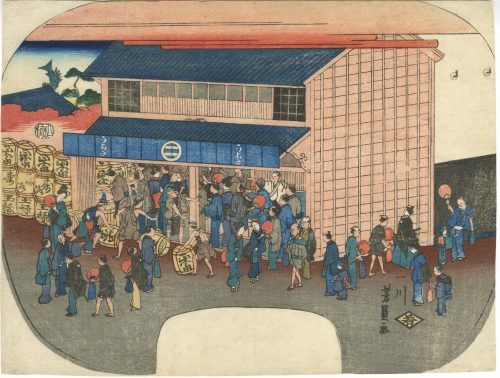 Artist: Utagawa Yoshikazu [歌川芳員] (Japanese, fl. c. 1850 – 1870). Publisher: Wakasaya Yoichi [若狭屋与市] (Japanese, fl. 1794 – 1897). Combined date seal and kiwame censor seal: 1861 (Man'en 2 / Bunkyū 1, from 19/02).
Artist: Utagawa Yoshikazu [歌川芳員] (Japanese, fl. c. 1850 – 1870). Publisher: Wakasaya Yoichi [若狭屋与市] (Japanese, fl. 1794 – 1897). Combined date seal and kiwame censor seal: 1861 (Man'en 2 / Bunkyū 1, from 19/02). -
 One of five fan prints from the series The Pride of Edo Compared to the Five Elements [Edo jiman mitate gogyo]. Artist: Utagawa Hiroshige [歌川 広重] a.k.a. Andō Hiroshige [安藤 広重] (Japanese, 1797 – 1858). Publisher: Ibaya Kyubei [伊場屋 久兵衛] (Japanese, fl. 1804 – 1851). Signed: Hiroshige ga Censor’s seal: Muramatsu Publisher's seal: Kinseido (Ibaya Kyubei) The text in the fan-shaped cartouche reads: "Water: The Square Aqueduct that Crosses by Suido Bridge Suggests the comparison of Ochanomizu to Water [Mizu: Ochanomizu josui no himasu Suidobashi areba gogyo no uchi mizu ni nazorau]". Ref: Rupert Faulkner. Hiroshige Fan Prints. Victoria and Albert Museum. Far Eastern Series. Hardcover - Harry N. Abrams, Inc. - 2001 [LIB-1344.2017] № 22, p. 51. Comment from Sebastian Izzard: This series of five prints features full-length figures of women set in landscapes around Edo compared to the five natural elements: fire, water, earth, wood, and metal. A preparatory drawing for the “Wood” image, featuring a woman crossing a bridge in the snow at the timber yards of Fukagawa, is owned by the Kanagawa Prefectural Museum of History in Yokohama. A preparatory drawing also exists for the “Earth” image, which portrays a woman seated on a bench at Nakabashi, for which no print is extant. Two examples exist of the “Fire” subject, which pictures a woman holding a lantern at night on an embankment, while in the river behind her fishermen employ fire to trap their catch. The “Water” image depicts a woman on a pleasure boat on the Ocha-no-mizu waterway. One example of the “Metal” subject is known, which was included in Izzard's Important Japanese Prints 1830–1860 March 14–20, 2020 exhibition [LIB-2398.2020], as №. 51.
One of five fan prints from the series The Pride of Edo Compared to the Five Elements [Edo jiman mitate gogyo]. Artist: Utagawa Hiroshige [歌川 広重] a.k.a. Andō Hiroshige [安藤 広重] (Japanese, 1797 – 1858). Publisher: Ibaya Kyubei [伊場屋 久兵衛] (Japanese, fl. 1804 – 1851). Signed: Hiroshige ga Censor’s seal: Muramatsu Publisher's seal: Kinseido (Ibaya Kyubei) The text in the fan-shaped cartouche reads: "Water: The Square Aqueduct that Crosses by Suido Bridge Suggests the comparison of Ochanomizu to Water [Mizu: Ochanomizu josui no himasu Suidobashi areba gogyo no uchi mizu ni nazorau]". Ref: Rupert Faulkner. Hiroshige Fan Prints. Victoria and Albert Museum. Far Eastern Series. Hardcover - Harry N. Abrams, Inc. - 2001 [LIB-1344.2017] № 22, p. 51. Comment from Sebastian Izzard: This series of five prints features full-length figures of women set in landscapes around Edo compared to the five natural elements: fire, water, earth, wood, and metal. A preparatory drawing for the “Wood” image, featuring a woman crossing a bridge in the snow at the timber yards of Fukagawa, is owned by the Kanagawa Prefectural Museum of History in Yokohama. A preparatory drawing also exists for the “Earth” image, which portrays a woman seated on a bench at Nakabashi, for which no print is extant. Two examples exist of the “Fire” subject, which pictures a woman holding a lantern at night on an embankment, while in the river behind her fishermen employ fire to trap their catch. The “Water” image depicts a woman on a pleasure boat on the Ocha-no-mizu waterway. One example of the “Metal” subject is known, which was included in Izzard's Important Japanese Prints 1830–1860 March 14–20, 2020 exhibition [LIB-2398.2020], as №. 51.
Metal. Izzard, 2020.

Fire. Faulkner, 2001.
-
 Kominato in Awa province [Awa Kominato] – one of five fan prints in the series Famous places in the Bōsō peninsula [Bōsō meisho], devoted to the trip undertaken by Hiroshige in 1852 to Bōsō peninsula (present-day Chiba prefecture). “Two fashionably dressed women beside the veranda of a wayside inn gaze out over Uchiura Bay toward the Tanjō Temple on the far shore, as a boat sets out to the sea from the fishing hamlet of Kominato. …Hiroshige’s viewpoint is from the lower slopes of Mount Kiyosumi”. Ref: Sebastian Izzard. Important Japanese Prints 1830–1860 March 14–20, 2020 exhibition [LIB-2398.2020], №. 52. Not in Faulkner's Hiroshige Fan Prints. Artist: Utagawa Hiroshige [歌川 広重] a.k.a. Andō Hiroshige [安藤 広重] (Japanese, 1797 – 1858). Publisher: Tsujiya Yasubei [辻屋安兵衛] Kinkaido [錦魁堂] (Japanese, c. 1842 – 1863) Date seal and double nanushi censor seal: Mera & Watanabe; Kaei 5, 11th month (1852). Signed: Hiroshige ga [広重 画] in a red cartouche. Size: Fan print (Aiban yoko-e uchiwa-e); 225 x 292 mm.
Kominato in Awa province [Awa Kominato] – one of five fan prints in the series Famous places in the Bōsō peninsula [Bōsō meisho], devoted to the trip undertaken by Hiroshige in 1852 to Bōsō peninsula (present-day Chiba prefecture). “Two fashionably dressed women beside the veranda of a wayside inn gaze out over Uchiura Bay toward the Tanjō Temple on the far shore, as a boat sets out to the sea from the fishing hamlet of Kominato. …Hiroshige’s viewpoint is from the lower slopes of Mount Kiyosumi”. Ref: Sebastian Izzard. Important Japanese Prints 1830–1860 March 14–20, 2020 exhibition [LIB-2398.2020], №. 52. Not in Faulkner's Hiroshige Fan Prints. Artist: Utagawa Hiroshige [歌川 広重] a.k.a. Andō Hiroshige [安藤 広重] (Japanese, 1797 – 1858). Publisher: Tsujiya Yasubei [辻屋安兵衛] Kinkaido [錦魁堂] (Japanese, c. 1842 – 1863) Date seal and double nanushi censor seal: Mera & Watanabe; Kaei 5, 11th month (1852). Signed: Hiroshige ga [広重 画] in a red cartouche. Size: Fan print (Aiban yoko-e uchiwa-e); 225 x 292 mm.


